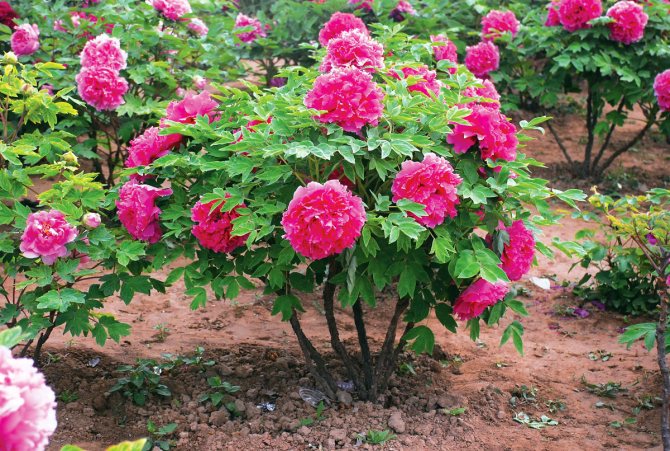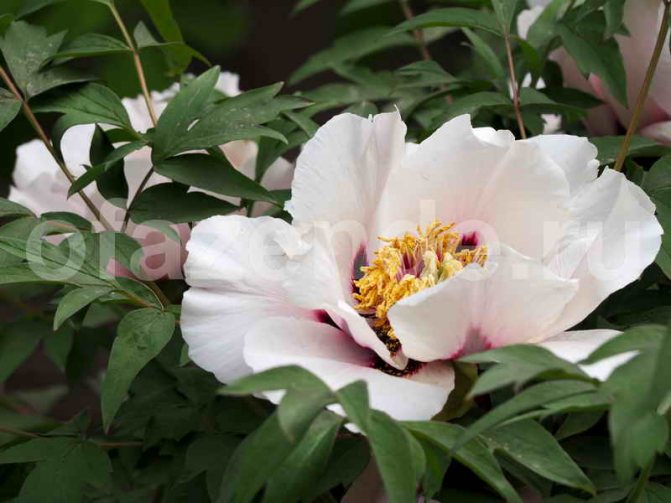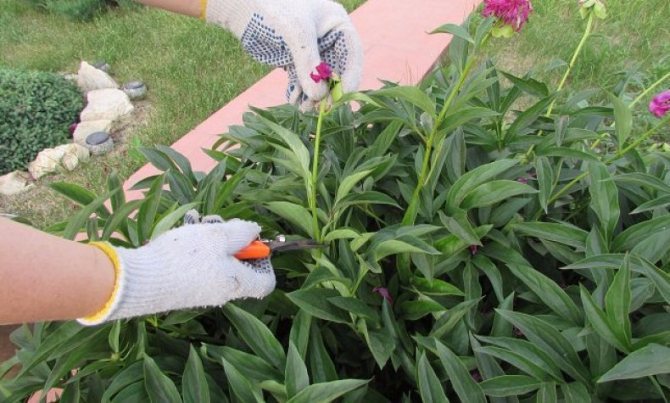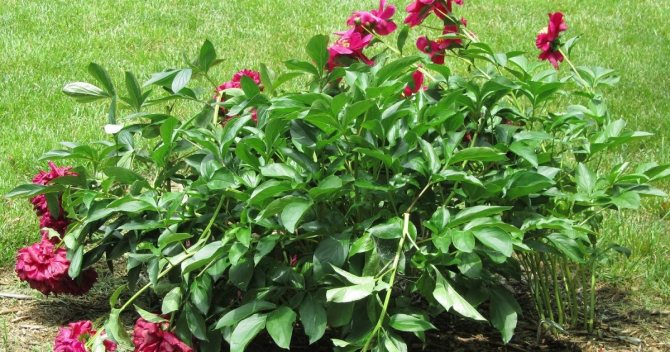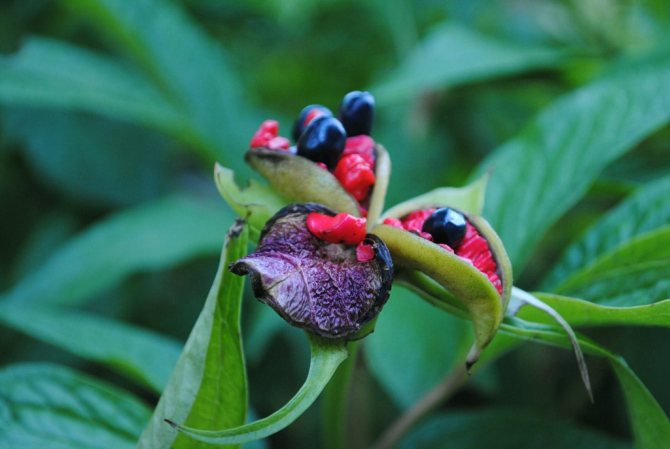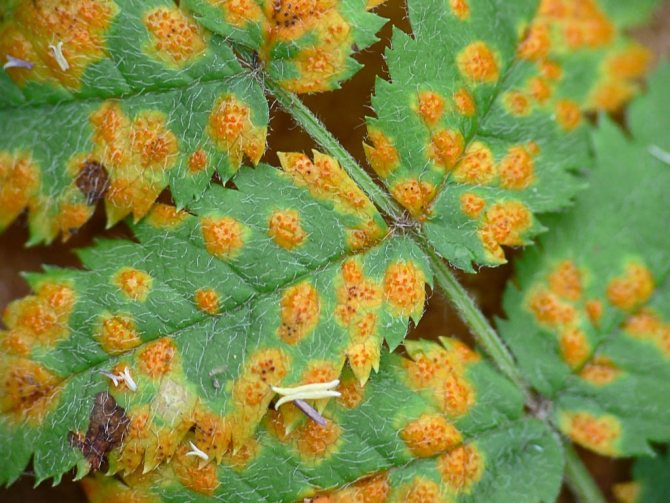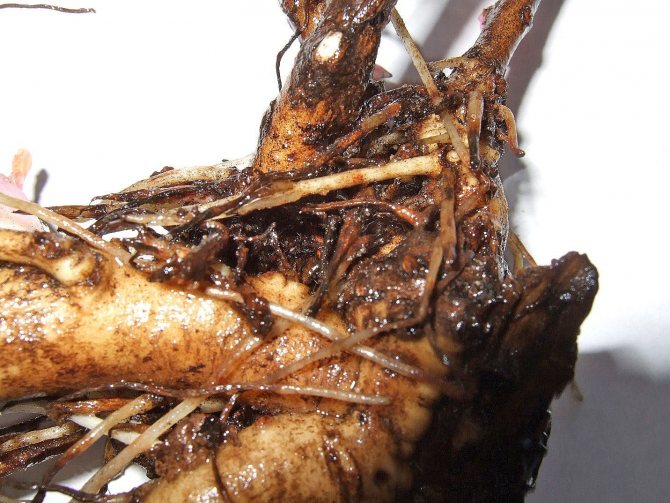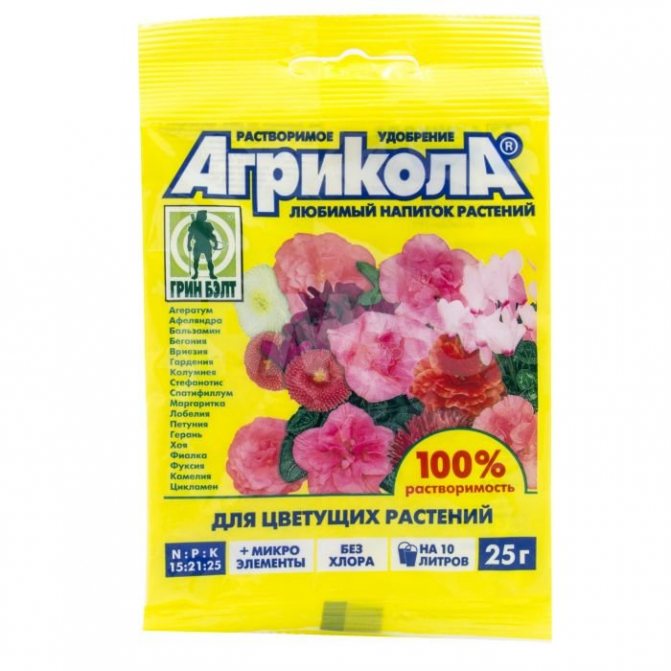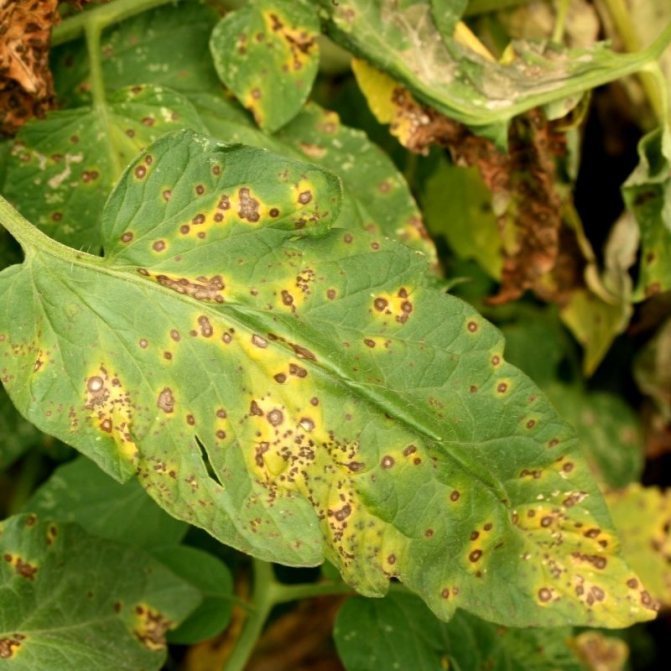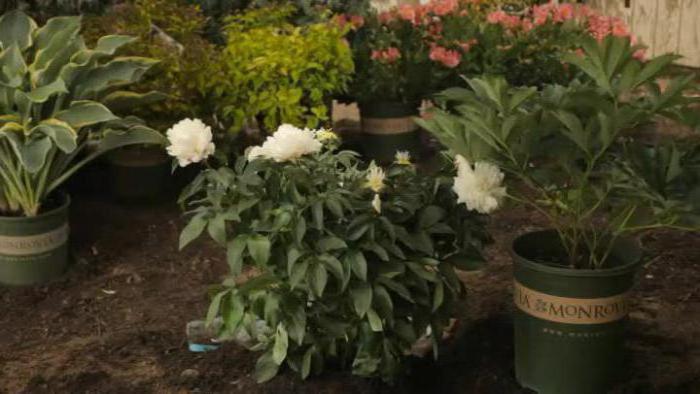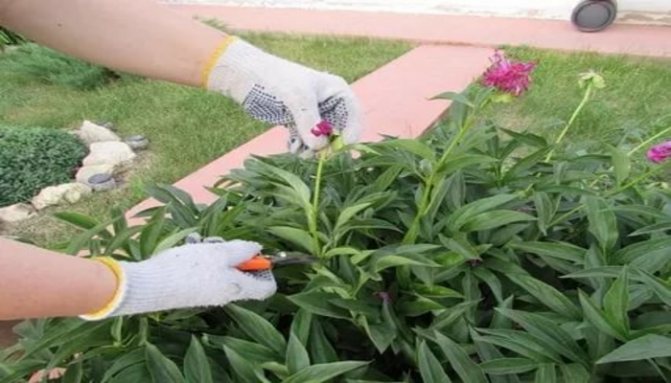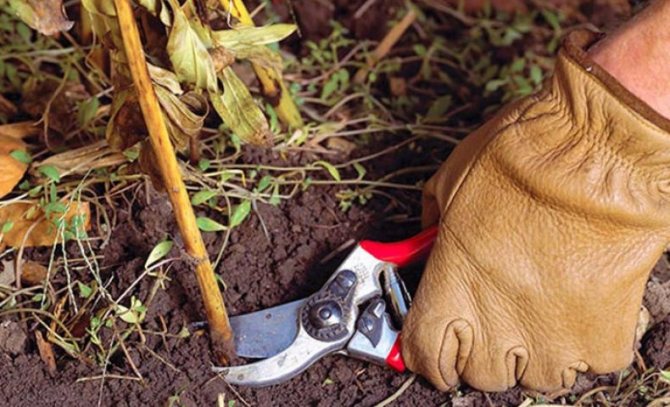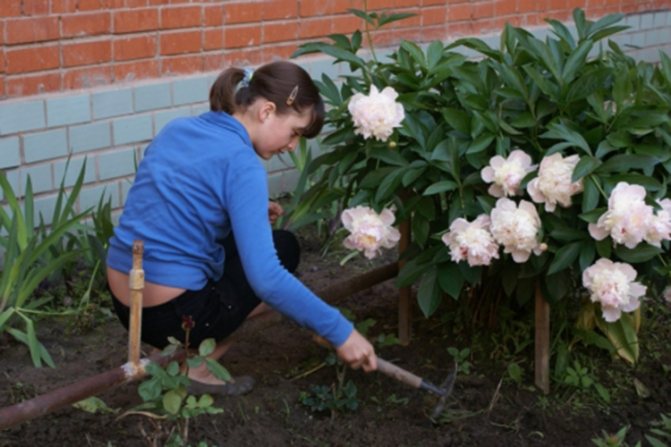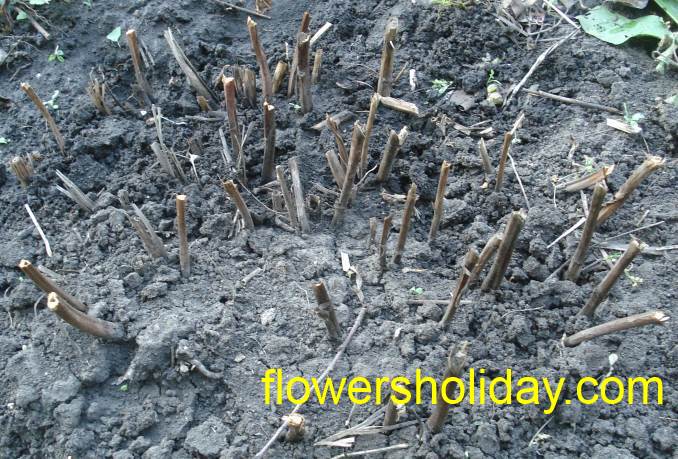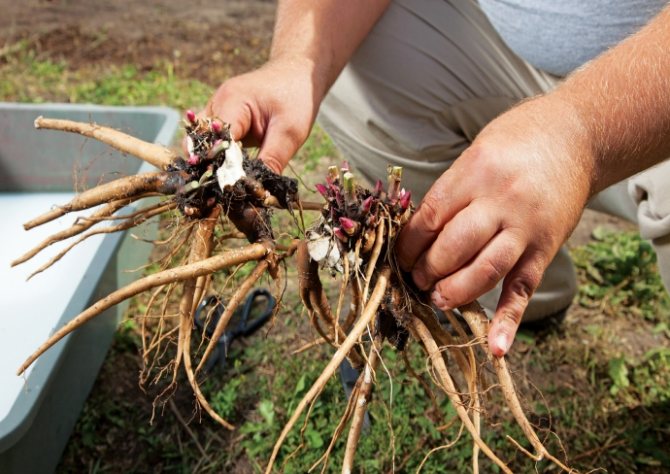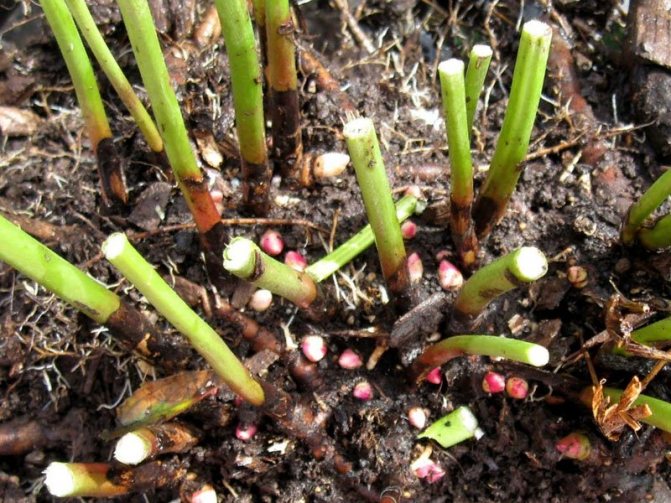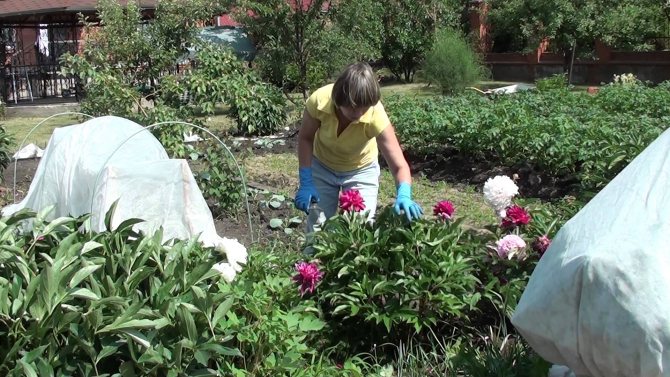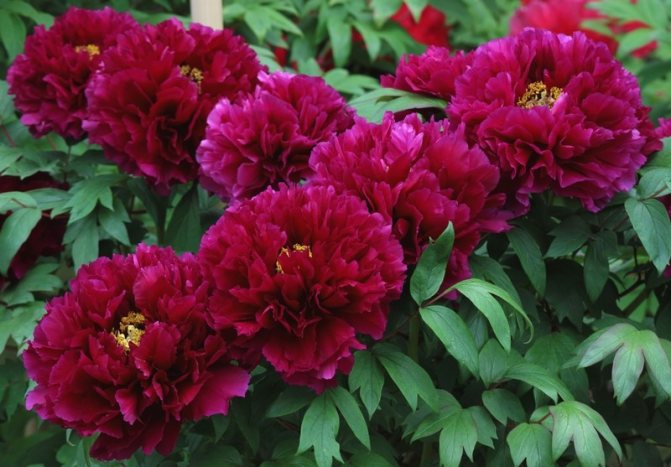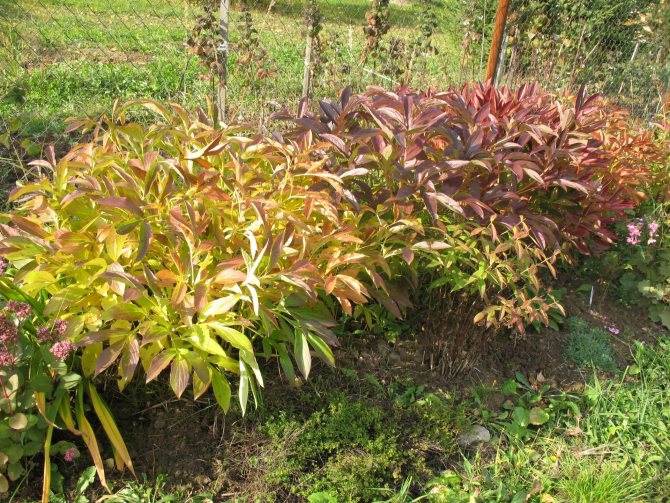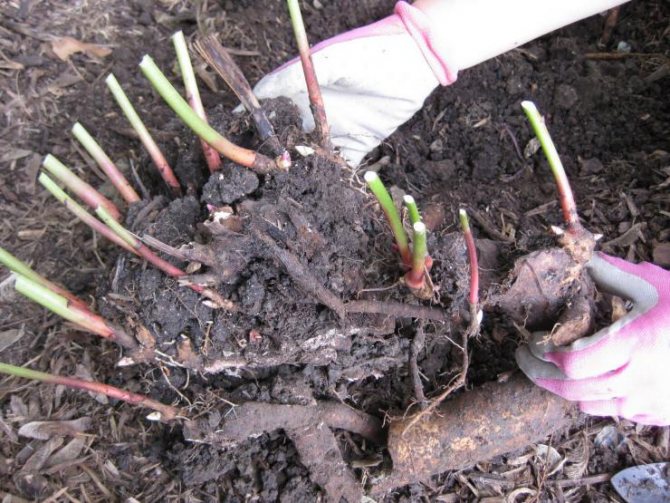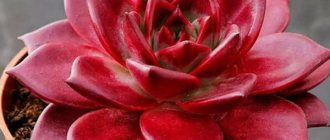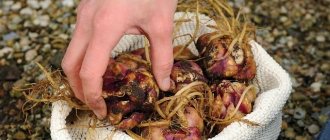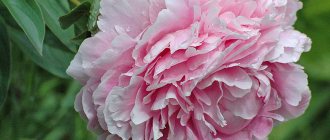Peonies are perhaps the most popular flowers. And many gardeners prefer to grow them, not only because they are unpretentious in care and do not require special attention. Their main advantage is a large number of beautiful, bright and large buds during flowering. Without a transplant, a peony bush can grow in one place for up to ten to fifteen years. But despite their unpretentiousness, they, like many flowers, sometimes ask to be taken care of. But at the same time, compared to other flowers, caring for peonies in the fall is not so burdensome. After giving your favorite flowers just a couple of hours, you will know with 100% certainty that with the arrival of summer days they will thank you with lush buds and a delicate aroma.
When to prune peonies after flowering
It is advisable to prune faded buds after all flowers have wilted (approximately in mid-June - early July). In this case, the head of the flower and the stem are cut off to the nearest leaf.
If the foliage looks weak, you can trim the stem above the sturdy leaf.
Do not cut off the stems completely after flowering. It is important to leave the branches with at least a couple of leaves, otherwise the bush may not bloom in the next season.
If you cut the peonies early, it may happen that the bush will bloom again. But such plants may not survive in cold weather.
When the peonies have bloomed
In no case should the stems of peonies with peduncles under the root be cut off immediately after flowering - this is a mistake that many beginners make, believing that protruding stems are ugly and spoil the look of the garden. Perhaps such stems do not really look very beautiful, but it is in them that juices and nutrients are formed that help bud buds for the next year. And if you cut off the stems ahead of time, then you simply will not give your peony the opportunity to gain strength and prepare for the next flowering.
Therefore, after the peonies have faded, only the dried flowers themselves need to be cut. You don't even need to do this if you want to collect seeds for propagation. However, this method of reproduction is rather long and laborious, requiring patience, and is not often resorted to. Therefore, you can safely cut off dried flower stalks, but the stem does not need to be touched until late autumn.
When to prune peonies for the winter
There are no exact dates for the work. You should focus on the climate of a particular area.
In autumn, foliage is cut off with the onset of the first frost.
In the suburbs and the Central lane
Autumn pruning occurs in October.
In Siberia and the Urals
The climate is characterized by short summers and early frosts. Plants are prepared for winter in September, combining pruning with hilling bushes with peat or wood chips to a height of 15 cm.
- the first frosts in the Urals begin in the second half of October;
- in Siberia, already in October, the average temperature becomes negative;
In the Leningrad region
Temperatures below zero are set in late October and early November.
In the south of the country
Peonies are processed in November. Drought often occurs in these regions, therefore, in September-October, peonies are well watered.
Ukraine
In the south of Ukraine, the temperature drops below zero in early December, and in the north - in mid-November.
Spring pruning of a tree-like peony is carried out no later than April, until the active movement of the juice in the trunk begins.
Belarus
The climate of Belarus is similar to the weather conditions in central Russia. Work to remove the aerial part of the peony is carried out during October.
The first frosts in Belarus are observed in early November.
Many novice growers make some mistakes when growing peonies. And one of them is early pruning of bushes - in the middle of the autumn season. The premature removal of the stems leads to the fact that the peonies do not have time to collect enough nutrients before winter. And in the spring they bloom weakly.
What is the difference between pruning tree and herbaceous peonies?
Peonies are tree-like and herbaceous. And they differ precisely by the fact that in winter the ground part of the herbaceous peony, in contrast to the tree-like one, completely dies off. Moreover, both plants are perennial.
The differences between plants are as follows:
- the stems of the tree-like peony are tough, and during the year of growth, its shoots become gritty. The herbaceous peony has soft shoots that grow every season;
- in the fall, the stems of a herbaceous peony die off, and the tree-like one simply sheds its leaves, like a shrub, its branches do not freeze;
- tree peony does not require transplantation and can grow in one place for much longer;
- the flowers of the tree-like peony are larger, and in some species can reach almost 30 cm in diameter;
- the tree-like peony grows very slowly, especially in the first years, and later blooms (in contrast to the herbaceous one, on which flowers appear in the third year after planting);
- the flowers of the tree-like peony are more varied in color than the herbaceous ones;
- the tree peony should be covered, even if the winters in your area are not very harsh. The herbaceous peony tolerates frost much more easily than the tree peony.
Given the different properties and characteristics of tree and herbaceous peonies, they also require different pruning.
Tree peonies must be slightly pruned in the spring, forming a bush - old dry leaves, broken branches, diseased and dried shoots are pruned from it. Such pruning is carried out in the spring, after you have removed all the covering material from the peonies.
The second pruning of a tree-like peony is done after the buds have swollen and started to bloom on the branches.
Treelike peonies are not pruned under the root either in spring or in autumn - in this species of plants, light superficial pruning is carried out exclusively to give the bush a shape. However, for tree-like peonies, pruning is very important, because not only the beauty and splendor of the bush depends on it, but also the decorativeness and duration of flowering. The main thing when pruning tree peonies is not to overdo it.
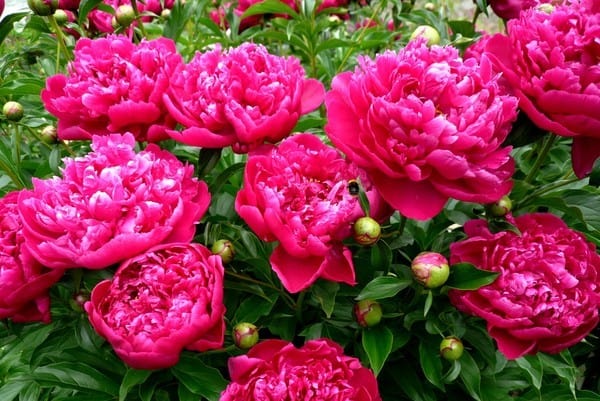
Pruning peonies after flowering according to the lunar calendar 2019
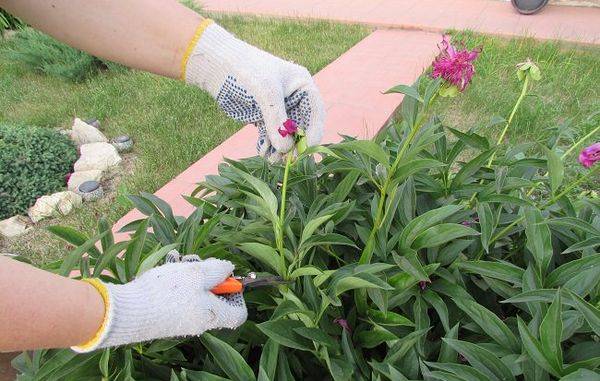

The influence of lunar rhythms on the life of plants and animals has long been known. If you follow the recommendations of the lunar calendar for summer residents, it is easier to care for the plants. Don't be afraid to miss important events.
Favorable days for manipulating plants (cutting, feeding, dividing, collecting seeds) in 2019 are indicated below:
July. 3rd and 4th number, 8-13 (up to 20 hours), 17-26, 31.
You cannot work with a peony: 1 and 2, 14 and 15, 27 (full moon), 28-30.
August. 1-9, 14-22, 27-31.
Unfavorable days: 10, 11 (new moon), 12, 23-25, 26 (full moon).
September. 1-6 (up to 5 pm), 10-19, 23 and 24, 27-29.
Plants cannot be disturbed: 6-8, 9 (new moon), 20-22, 25 (full moon).
October. 1-3, 10-16, 20-22, 25-30.
Prohibited days: 4-6, 9 (new moon), 17-19, 24, 31.
November. 4-6, 8-12, 21 and 22, 25 and 26.
Unfavorable numbers: 1, 7 (new moon), 23 (full moon), 27-29.
Pruning in the early years of life
Gardeners want to quickly see how a new plant is blooming. But there is no need to rush. The first and second year buds need to be cut off before flowering, immediately after they appear. This will give an impetus to the growth of the bush, and then abundant flowering.Indeed, a lot of strength and energy is spent on the formation of a bud and flowering, which a young plant has little. Remove the flower itself. Do it in the morning or evening. The stem and leaf are not removed. This weakens the plant.
When to prune peonies after flowering? In the third year after the beginning of the formation of buds, they are allowed to bloom.
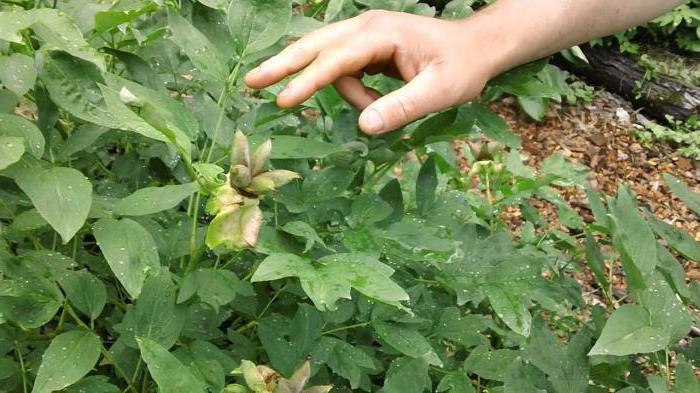

Should peonies be pruned after flowering? This is done immediately after they have faded. The heads are removed, leaving only a few upper flowers on the bush. Then the bush in the following years forms a large number of buds. The same is done for the next year. In tree peonies, you can adjust the size of the flower. In order for them to be large, a third of the formed buds are cut off.
Some experts argue that in the early years, flowers are allowed to bloom, and are pruned immediately after wilting. It is necessary to decide whether it is necessary to cut the peonies after flowering or before it, based on the state of the bush. If he is quite developed, then you can leave. If it is weak, it is better to remove it.
How to prune peonies correctly
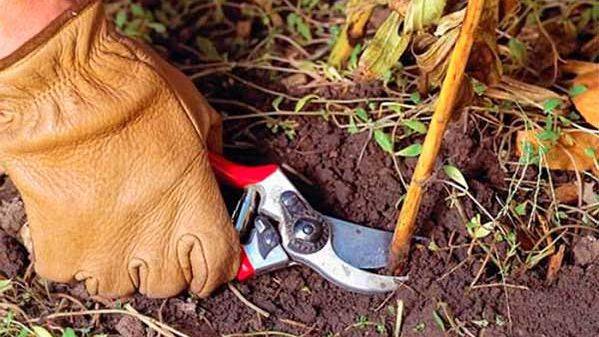

Treelike and herbaceous peonies can be distinguished. There are more than 1000 species of tree peonies in the world and about 5000 varieties of herbaceous ones. Plants differ in flowers (color, size, shape), flowering time, height and shape of the bushes. The popularity of plants is also due to unpretentious care. But to ensure full growth and maintain abundant flowering, it is important to comply with the requirements for pruning the bushes.
The most important for the plant are 30-45 days after flowering. It is during this period that renewal buds are laid and developed, which will bloom for the next seasons.
It should be remembered that renewal buds are formed at the base of the stems.
Therefore, when cutting flowers, be sure to leave a stem with several leaves.
How to prune peonies correctly:
- the entire aerial part of the herbaceous varieties is removed;
- in tree-like peonies, stems are left 20-30 cm high from the root;
- it is recommended to cut the cut above the kidney (approximately 3 cm apart).
Herbaceous varieties
These peonies are considered the most durable. Plants are undemanding to care for, grow and develop well in different climatic conditions. Moreover, it is important that plants adorn summer cottages and flower beds not only during flowering. Openwork green foliage in rich shades perfectly decorates areas after the buds have wilted. Peonies make a great backdrop for other flowering plants all summer long.
Various varieties of herbaceous peonies amaze with the magnificence of double, crown, semi-double, pink flowers. The stems grow to a height of 40 to 100 cm. Depending on the variety, the flowers can be from 10 cm in diameter (Peregrina Rosabella peony) to 30 cm (White Wings variety).
For the first two years, the root system is growing in the bushes, so it is advisable not to allow flowering.
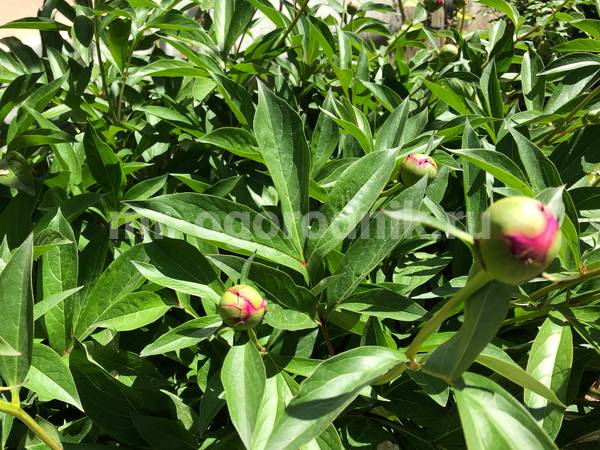

Do I need to cut the peduncles of peonies?
- In the first year of plant life, it is recommended to cut off all the buds.
- In the second year, one bud is left until it bursts. Then you can cut the flower (as short as possible) and put it in a container of water.
Once the bud is in full bloom, it's easy to evaluate the peony variety. Although it is believed that the first flowers do not always correspond exactly to the characteristics of the variety. It is possible to more accurately assess the beauty and features of the species only in the third year of the life of the bush or even later.
In herbaceous peonies, the aerial part completely dies off in autumn, and only the underground root system remains to live. The stems and leaves are cut in the fall, on the eve of frost. Early pruning is harmful to the bushes - from the stems and leaves, nutrients are sent to the storage roots and the premature removal of the green mass will greatly harm the plant.
After pruning, the peony is fed with wood ash, scattering it around the bush, in a dose of 100 - 150 g.You can use a ready-made complex of phosphorus-potassium fertilizer.
Step-by-step pruning of peonies of this variety and preparation for winter
Starting from mid-October, with the onset of the first frost, we cut off all the stems up to 2-4 cm with a sharp pruner. If this is not done, then during the winter they will freeze and rot. Pests will start in the leaves that will destroy the flower.
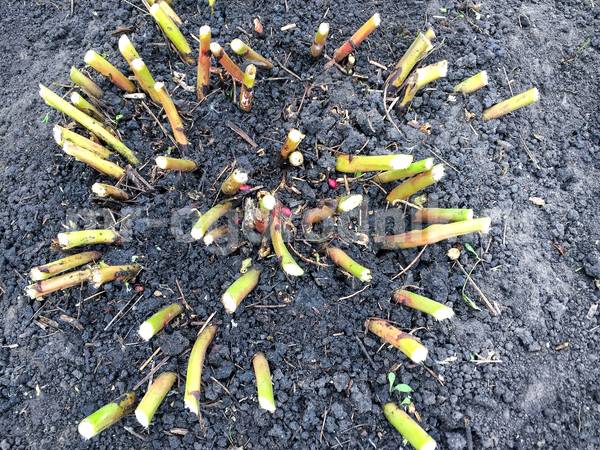

Fertilization
Take a small rake and gently loosen the soil around the stems. We introduce mineral fertilizers: potassium, phosphorus.
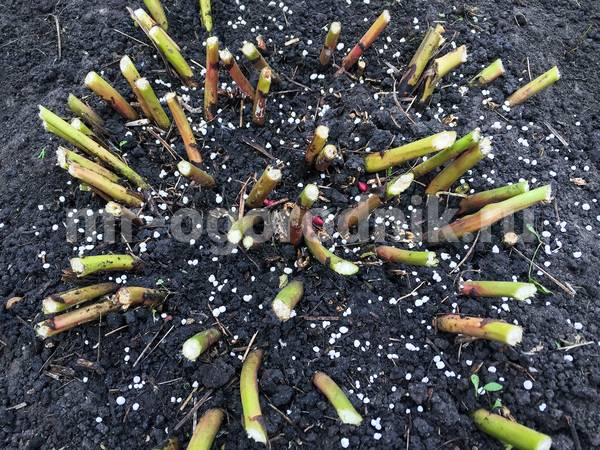

If the weather is dry, we use liquid top dressing. Enough will be 1 liter per bush. In rainy weather, sprinkle with fertilizer in granules. If there is no such top dressing at hand, scatter bone meal or wood ash.
Fertilization helps to strengthen the root system. Healthy and strong young shoots grow in spring.
Shelter peonies for the winter
If the flowers are planted among trees or shrubs, then they are easier to tolerate the winter cold. As the snow lingers and creates additional insulation.
In an open or elevated place, we thoroughly cover the plant for the winter.
In the spring:
- We remove the branches and rake some of the mulch.
- We leave a small layer of humus or peat under the bush. This will protect the plant from weeds.
From the correct pruning and timely shelter of peonies, their luxurious and lush flowering depends on the next year.
When are peony leaves cut?
As soon as they fall. The cut is made at the level of the soil and all the tops are necessarily burned to prevent the possible spread of diseases.
The remains of the bushes can be sprinkled with ash (literally 2-3 handfuls for each plant). It is not required to specially cover adult bushes. In winter, the root system is gaining strength. Adventitious roots are formed, which thicken as they grow and turn into tubers.
Tree peonies
It is a deciduous shrub with thick, erect stems 1.5-2.0 m high. Perennial shoots are slightly branched. At the end of the seasons, the stems do not die off, but gradually grow, giving the bush a spherical shape over time. Flowers with a diameter of 12-20 cm grow at the ends of the shoots. Moreover, the older the plant, the more luxuriant it blooms.
Such peonies are often used in landscape design. Beautiful simple, double, semi-double flowers picturesquely decorate flower beds, garden paths. Thanks to the rich range of shades (white, pink, raspberry-purple), it is easy to choose a variety for decorating a flower garden.
At the beginning of April, they carry out sanitary pruning and shaping (optional). Damaged / broken, dry branches are necessarily cut off. If it is difficult to isolate dried branches, then it is better to prune a second time when the buds are blooming.
The tree peony can be grown as a small tree. In this case, excess shoots are removed. If you like the bushy shape, then they retain several strong trunks. To prevent the bush from thickening too much, the extra stems are cut off.
In young plants, in the early years, a third of the buds are cut off so that lush flowers form in future years.
Treelike peonies bloom earlier than herbaceous ones by about 10-14 days. Flowering lasts two to three weeks.
In this article, we've covered when to prune peonies after flowering and when to prune peonies for the winter. Even beginner growers can successfully grow beautiful flowers if they adhere to simple plant care rules.
If the rose is the “queen” of the garden, then the peony is definitely the “king”. The fact that it fades in June does not at all make it an outcast from the gardening society: the greenery near the bush is lush, in the fall the leaves of some varieties turn red - which in itself greatly adorns the flowerbed. Well, there are countless varieties of modern peonies - just know, choose the taste!
I personally really love the white-flowered, pink and yellow varieties of peonies. Now, by the way, it is a very suitable moment for planting new varieties. The market is full of all sorts of different ones, and today, walking around the bazaar, I have already coveted a gorgeous spherical peony of a delicate lemon color.True, he is so beautiful only in the photo, it looks something like this:
So I still think whether to buy or not - there is still enough time.
Trim the peony in the fall or not?
This question is very often asked by beginner and quite experienced gardeners. Pruning, of course, is necessary, so you will avoid the risks of frostbite of the plant during winter frosts, and at the same time carry out sanitization of the plant, ridding the bushes of the shoots and leaves that have become unnecessary. In winter, the plant will winter calmly, and in the spring, with renewed vigor, they will begin to build up the "tops".
When to carry out the procedure?
When the vegetative cycle of the plant ends. How to determine this? If you see that the peonies are "sad", become downcast, the leaves have begun to dry, and the stems have died - it's time! In central Russia, this period begins, usually closer to the end of October.
Stock up on a well-sharpened tool, a supply of peat and mulch - and forward to the flower bed.
How to prune peonies?
As my dad says - "completely". That is, we cut off all the shoots near the bush, leaving only "stumps" 6-8 cm high. Pruning is done with a sharp pruner, and shoots with leaves are removed. Experienced growers recommend burning them - this will be a preventive measure against the spread of pathogenic bacteria and, especially, fungal spores, which are very fond of settling in withered foliage.
Attention! If the peony is tree-like, then you cannot cut off the branches "completely"! We make a formative pruning of the bush, leaving a lignified "skeleton". We do full pruning of the bush no more than once every 10 years - for rejuvenation.
What to do next?
Caring for peonies is not very difficult. After only stumps remain in place of the gorgeous bush, we easily loosen near the peony, not 3-5 cm in depth - at the same time remove all sorts of different roots and other "byaka". Now you can mulch the flower: sprinkle the stumps with a layer of peat, and on top you can cover it with straw, spruce branches or other convenient mulch. Whether or not to cover peonies additionally, see for yourself - if the winters in your region are snowy and frosty, then you can make an additional layer of film. If everything is in order with the snowdrifts, frosts are rare, or winters are generally warm and mild, no additional insulation is required.
Need to feed the peony in the fall?
In principle, you can feed. But if you do not feed, nothing terrible and terrible will happen. Autumn feeding is not in favor of the plant, so we will only enrich the soil, which has been depleted during the season. So the introduction of top dressing is, as it were, "for future use" for the future. Therefore, if you leave everything as it is, and add top dressing next spring, then there will not be much difference. If you still want to fertilize the earth a little, then buy a complex mineral fertilizer for flowering marked "Autumn" - this will not contain nitrogen. Nitrogen to flowers in the fall is like a fifth wheel to a cart - to nothing.
Transplanting peonies in the fall
Peonies are perennial flowers that can grow in one place for up to 10-15 years. This is indeed the case. But given that over such a long period the land on which they grow becomes scarce, and old roots can cause diseases of young and fragile roots, it is still worth replanting them at least once every 5-6 years. This way, you will not only rejuvenate the peony bushes and enrich the soil, but also provide your favorite garden flowers with more lush bloom.
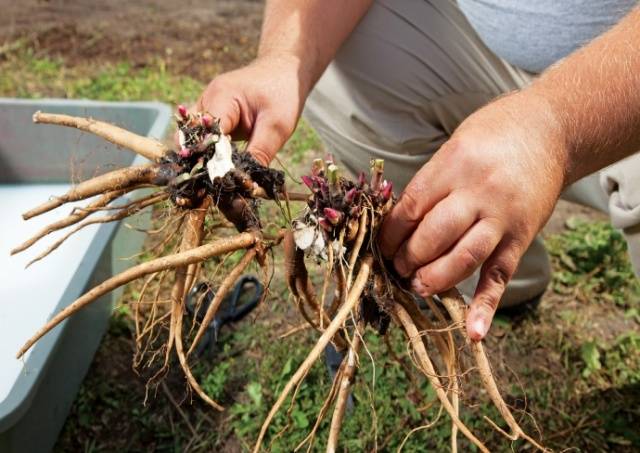

It is necessary to plant peonies in early autumn. In Siberian regions with a harsh climate, this process should be postponed to the third decade of August. In this case, the plants will be well accepted, and the root system of peonies will have time to absorb all the substances necessary for growth and development by winter.
Planting is best done in warm, dry weather. But the soil on which the flowers grow must be moist. This will make the digging process much easier, and you will not damage the young roots.If the soil is dry, water the peonies abundantly 1-2 days before replanting.
You need to carefully dig up old bushes, trying not to damage the buds and shoots. Gently shake off any residual soil and rinse with water. Examine the rhizomes carefully for rot and disease. Separate old, tough, damaged and obsolete roots from young ones. Place young roots in a light pink solution of potassium permanganate (potassium permanganate) for 30-40 minutes. And the obsolete rhizomes should be immediately removed from the site.
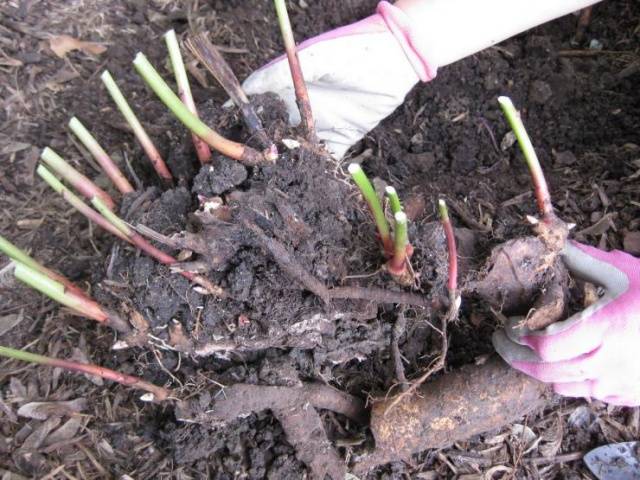

Important! In the first year, the buds on young peony bushes should be cut as early as possible to allow the plants to develop an excellent root system.
After processing, plant the divided roots in prepared soil. It is not recommended to plant peonies in the old place. Better to find another site for them. Keep in mind that the new place should be sufficiently lit - peonies are very critical to the lack of sunlight, which immediately affects flowering. Strong and piercing winds are undesirable for garden flowers. It is advisable to take care of the preparation of the soil in advance: about 3-4 weeks before planting, loosen and fertilize the site well with superphosphate. Nitrogen fertilizers should not be used during autumn transplantation.
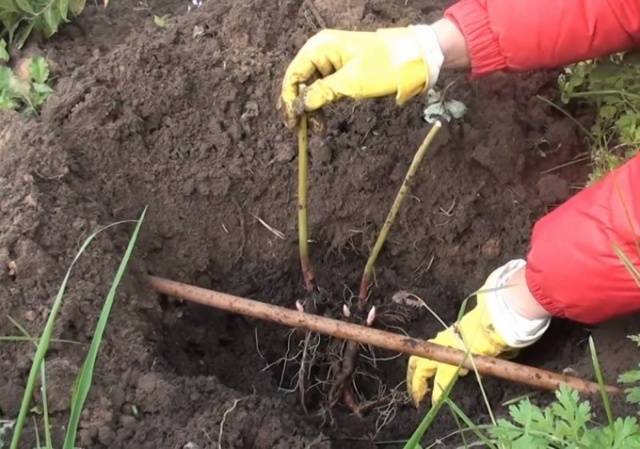

A planting hole for peonies needs to be dug out quite spacious - at least 40-50 cm in depth. It is very important that the roots are located freely in it. Place a prepared mixture of compost and wood ash in a 3: 1 ratio on the bottom. Now carefully, trying not to break the young shoots, place the roots in the hole. Keep in mind that the top bud should protrude slightly from the ground. But no more than 1-2 cm. Fill the hole with soil and water the transplanted peonies abundantly.
After transplanting, do not forget about your pets and, in the absence of precipitation, water at least 2-3 times a week. Peonies transplanted in the autumn do not need additional feeding.
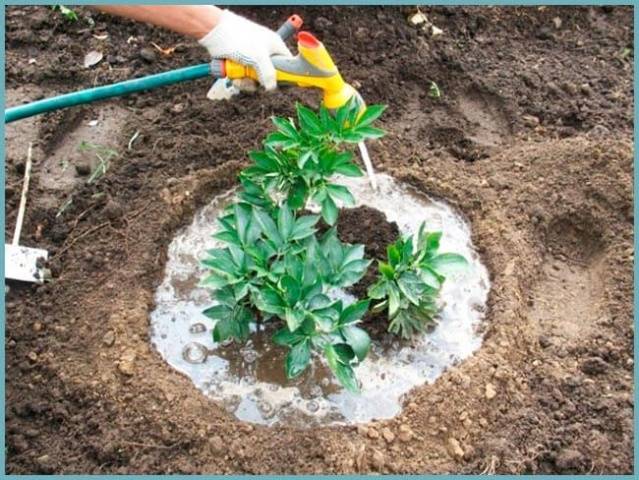

You will learn the basic rules for transplanting and planting old peony bushes from the video:
Autumn rules for caring for peonies
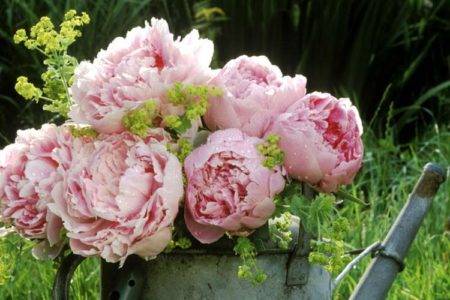

Spring and summer care includes: regular watering, loosening the soil in the root zone, killing weeds and removing buds that end flowering. And caring for peonies in the fall means pruning the bush, feeding it, and sheltering for the period of cold weather. In order for the shrubs to survive severe frosts, they perform the following actions:
- Shrubs that bloom are fed.
- If necessary, transplant some shrubs to a new location.
- Cut off the bushes.
- Cover the soil with mulch.
The list of these activities is necessary to prepare the plant for winter. You don't need to perform anything unique, these universal actions are enough.
Feeding peonies in autumn
If peonies bloom magnificently every year, then a logical question arises: why, in general, feed them? It would seem that the bushes have faded, and do not require special care until spring. In fact, this is far from the case. Having given all their strength in spring to the active growth of green mass and bright buds during the flowering period, by autumn their root system is very weakened. And during this period, the formation of new roots begins and the preparation of the plant for winter. Feeding peonies in the fall is simply necessary so that they can get the maximum possible amount of nutrients. The root system of these garden flowers is arranged in a special way. In a certain part, the roots are the thickest and fleshyest. It is in these areas of the root system that all minerals and nutrients accumulate in the fall. During the period when the active growth of the aerial part of the plant begins in spring, all the accumulated "vitamins" are given by the roots to growing bushes and large buds.
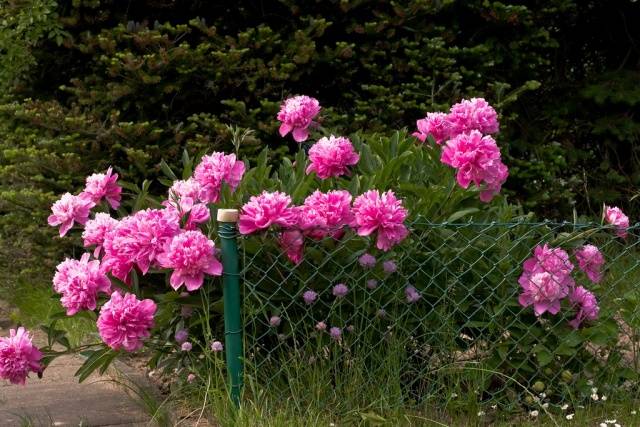

Experienced gardeners advise feeding peonies in the fall from mid-September to the second decade of October.But taking into account the peculiarities of a particular region, one more important factor must be taken into account when determining the optimal timing for feeding peonies - the approaching frost.
Advice! It is desirable to fertilize the plants 1-1.5 months before the first frost.
Feeding peonies in the autumn has its advantages:
- In early spring, the buds will be much larger and stronger. Their number will also pleasantly surprise you.
- For timely feeding, peony bushes will thank you with more lush and bright buds.
- After feeding, the peonies grow faster, the bushes quickly increase in size.
How, when and what to feed peonies in autumn, in order to admire the bright and unique flowers in the summer? At this time, phosphorus-potassium fertilizers will be useful for them. It is better to leave nitrogen-containing fertilizers until spring, as they stimulate the rapid growth of the aerial part of the plant. And in the fall this is undesirable. The shoots will freeze at the first frost.
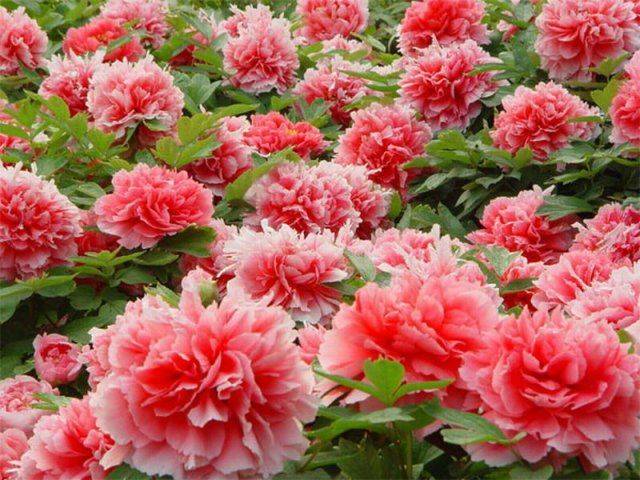

There are two ways to feed peonies in autumn: dry and liquid. Each method has its own advantages.
Important! Peonies should be fertilized only in the third year after transplantation.
Dry feeding of peonies
The dry method is most often fertilized with peonies in particularly rainy weather. The liquid method in this case is not suitable for the reason that the roots have already absorbed enough moisture during the rainy season. They will absorb the minimum amount of fertilizers. For the dry method, it is best to purchase a feed in the form of granules. So, it will be easier for you to control their number and it is more convenient to apply them to the soil. Such dressings work much longer than their liquid counterparts. The plant receives all the nutrients in small portions, that is, dosed.
Spread an incomplete handful of granules evenly around the peony bush. To prevent them from being washed away with the first rain, slightly loosen the ground under the plant, as if mixing the soil with fertilizer.
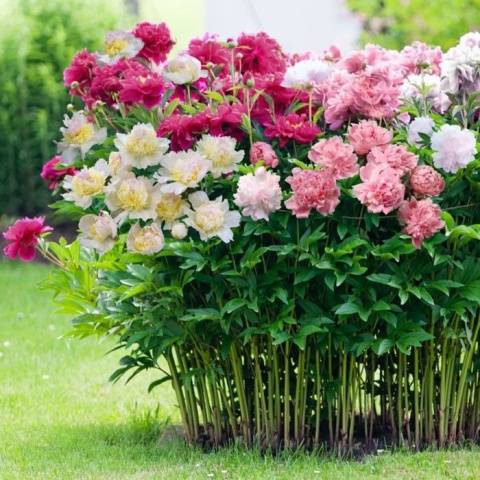

Liquid feeding of peonies
Liquid feeding of peonies in autumn is ideal if there is very little rainfall and the soil under the bushes is dry. In this case, granules containing mineral and organic matter are not suitable. It is better to use a supplement in the form of tablets. Optimal dosage: 1 tablet in a bucket of water. The life-giving cocktail needs to be mixed very well. Water your peonies with the resulting solution at the rate of 1 liter of liquid per bush. If the bushes are very large, then the dose can be increased.
Important! Whichever method of feeding you choose, you need to apply fertilizer very carefully. It is advisable that the additives do not fall on the root neck of the peonies.
The meaning of autumn pruning
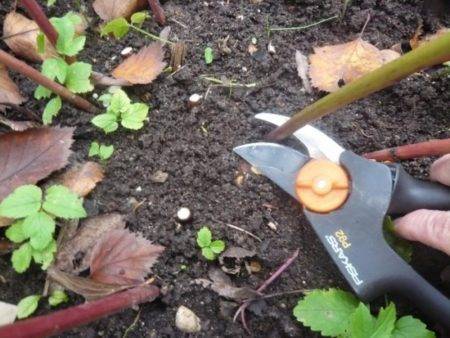

Novice gardeners prune the leaves when the bushes fade, because the wilting shrubs greatly spoil the appearance of flower beds. Crop experts believe that it is best to prune the leaves when the cold weather sets in. What will give positive results for the shrub:
- Before the onset of winter cold, plants restore their root system.
- Moisture accumulates in the root tubers so that the flowers can germinate in the spring.
- Peonies store energy after the end of the flowering period.
Care
Peonies are very undemanding plants. It's easy to look after them. They tolerate winter well, they can grow in one place for a long time, up to fifteen years. They bloom in spring, when there is still moisture in the ground. But during the period of bud replacement, he needs water. If the soil is dry, then the peony needs to be watered. After the moisture is absorbed into the soil, it is loosened, but shallowly - up to 8 cm. Otherwise, you can damage the young shoots and even the tubers of the plant.
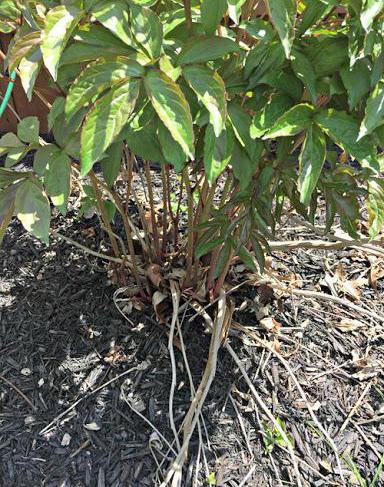

The weeds around the peony are removed. But they are not growing very actively. After all, the peony has a thick, wide crown that suppresses young weeds at a young age. The soil around the bush can be covered with a layer of mulch. It will protect the flower from drying out the soil and the appearance of weeds.
Peony responds well to feeding. When planting at the root, such an amount of fertilizer is applied, which is enough for three years.Then the bush needs to be fertilized by adding nitrogen and potassium. The first time this is done when the sprouts reach 10 cm. When the buds appear, they feed it a second time. Then, during and after flowering, potassium and phosphorus are added.
You can feed it with infusions of mullein or chicken droppings.
But you shouldn't fertilize the peony too much. An excess of introduced substances leads to the opposite result.
When to prune bushes in fall or spring
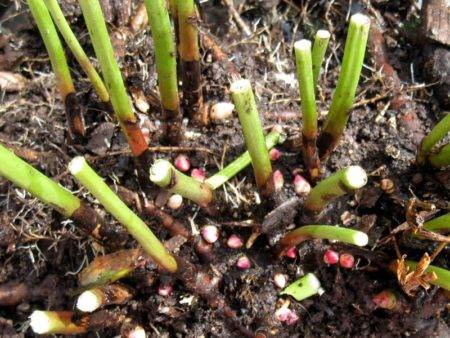

Gardeners definitely need to figure out when to prune peonies in the fall or leave them in the spring. Timing plays an important role. For the first time, the plants are cut off after the flowering of the bushes. But only the buds themselves are removed, without touching the stems and leaves. Please note that after flowering, photosynthesis continues in the stems and the remaining foliage. The plant restores strength for the further growth of bulbs, accumulates energy in order to survive the winter frosts. Therefore, the final pruning of the leaves is carried out later, after the onset of the first persistent cold weather.
Features of pruning a tree peony
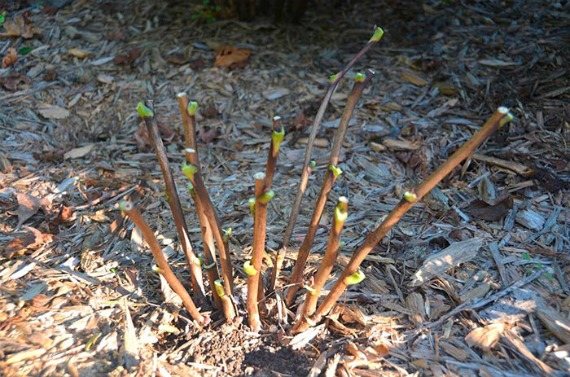

- Sanitary, anti-aging and decorative pruning of the tree peony is recommended only in spring.
- A sanitary "haircut" should be done every year. It involves the removal of dry branches completely and frozen ones - to a living bud.
- Plants require a rejuvenating procedure after fifteen to twenty years. The branches are cut at the root, which activates the growth of new shoots and gives new strength for further development.
- The shaping "haircut" is carried out for the first time only in the third or fourth year of life. Remove dry, damaged, weak and thickening shoots.
- To enhance the growth and size of the inflorescences, for a more lush and abundant flowering, a certain number of small buds should be pruned.
- Annual autumn pruning of a tree-like peony (under the root) is not carried out, since their thick and strong tree-like stems are not afraid of winter frosts and perfectly tolerate cold periods. But the unviable old branches must be shortened by ten to fifteen centimeters.
- After the end of flowering, it is necessary to remove only faded buds, and in the autumn, ripe seed pods are cut off.
- For the full development of a tree-like peony, it is recommended to cut off the root shoots annually.
Cutting sequence
Pruning peonies requires a certain sequence of actions:
- First, the instruments are prepared and, if necessary, disinfected.
- Shoots are cut, leaving a length of 2 cm so that the bush can grow further.
- In tree peonies, only the leaves are cut off.
- After removing the stems, you need to add fertilizer to the ground and dig the soil near the bush, loosen the root circle.
- Leaves and stems are folded cut into one pile and burned or dumped into a compost pit.
How to transplant peonies?
Mature plants often require transplanting. Peonies are often transplanted after flowering - this plant grows quickly enough. at the same time, it easily tolerates a transplant and decorates even the shady corners of the garden - the peony tolerates partial shade well and the absence of the sun does not greatly affect its decorative effect - the flowers may not be as large as those of flowers growing in sunny areas, but if you regularly fertilize your plant , take care of it and carry out pruning of peonies in the fall, the flower will retain its decorative effect in the shade.
It is optimal to transplant peonies in September, when the plant has already accumulated nutrients and will easily take root in a new place. However, even after flowering, peonies can be safely planted in a garden or front garden.
Prepare a large hole in the chosen place - the roots of the peonies are powerful enough, fill it halfway with soil, add humus or peat and, placing the plant there, fill it with earth on top.
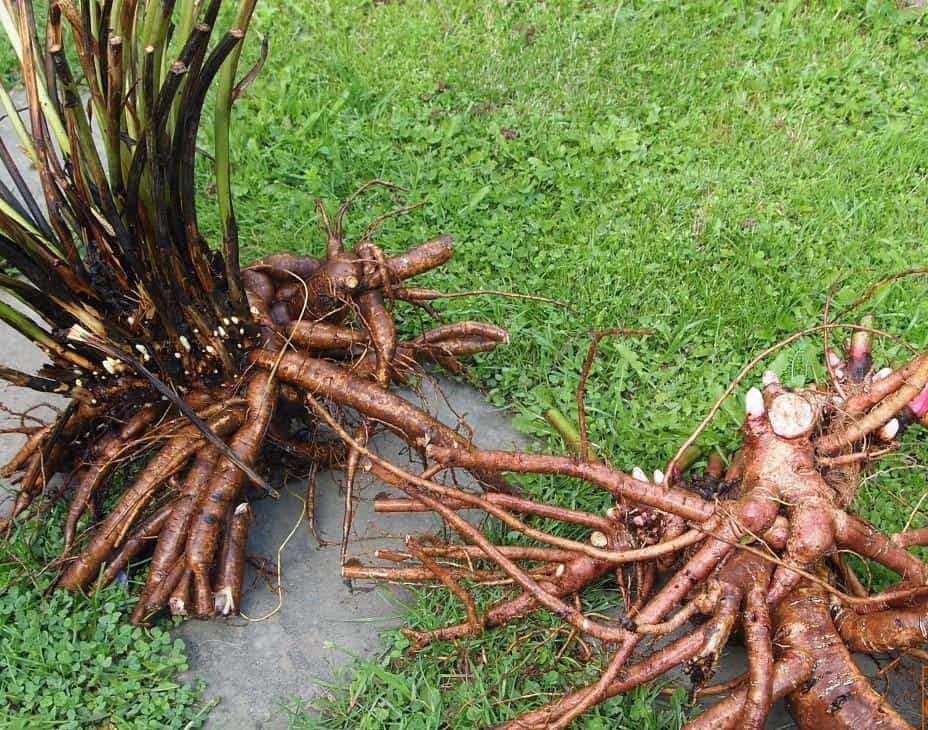

There is no need to tamp the earth around the root, as the peony buds can be easily damaged.Therefore, it is enough to thoroughly sprinkle the rhizome with earth and pour abundantly on top with warm water. Next year, young plants will delight you with fresh shoots.
By the way, it is better to cut off the buds that appear for the first two years, so that in the future the flowering is more abundant. And if you need large flowers (for example, for cutting for bouquets), then you should leave only the upper buds, and remove the lateral ones. The fewer buds on the peony, the larger the flowers will be, and the longer it will bloom.
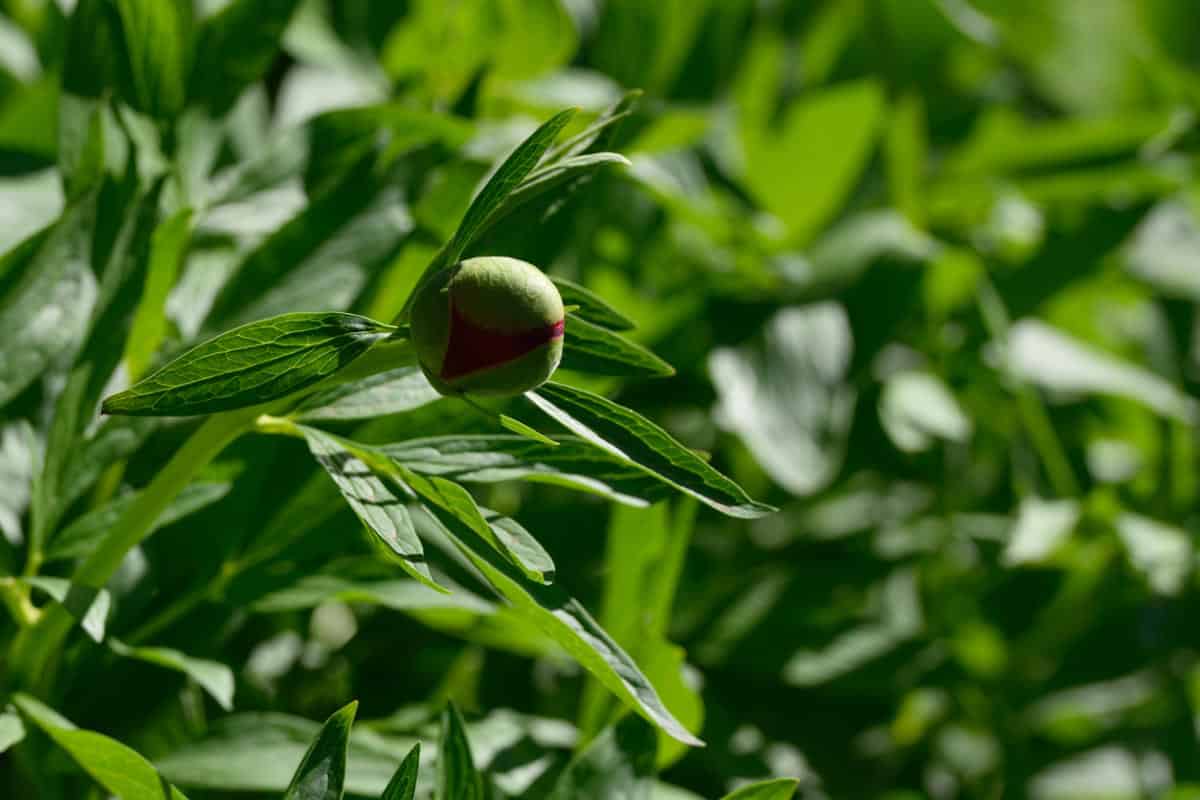

.
Instructions
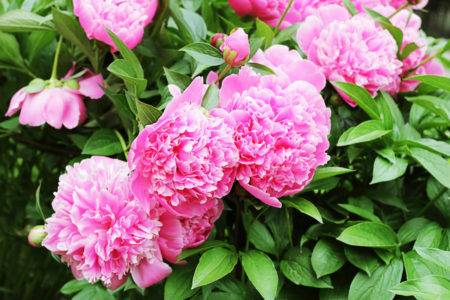

The process of pruning regular peony bushes is simple. This event begins when the foliage from the cold falls on the ground. Frosts start at different times depending on the climatic zone, so there is no specific date. You need to navigate by the appearance of a peony on your own site. The stem is cut off almost completely. It is only necessary that the stem sticks out of the ground by 2-4 centimeters.
Pruning a tree peony in the fall is done according to a different principle. Formative pruning is done when they want to make the bushes more beautiful, to increase the number of buds or the size of the flower, by removing the side shoots. The stems are shortened in height to a maximum of one meter. This will help the plants grow thicker and more flowering buds. In addition, cut off stems are much easier to cover before the winter cold.
You need to prune the tree peony for rejuvenation once every 10 years. If the bush does not bloom so densely or stops blooming altogether, then it is time to carry out a renewal pruning. Old shoots are removed, thereby provoking the growth of new ones. With systematic proper care, the life expectancy of shrubs is approximately 70 years.
Caring for peonies after pruning, feeding
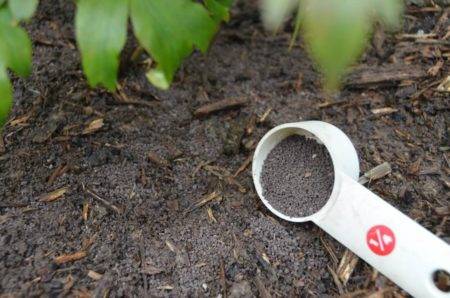

You need to feed peonies before winter dormancy 10-14 days before frost. This is approximately from the second half of September to the first half of October. Fertilizers are added on dry warm days. It is important that the top dressing contains phosphorus and potassium. These substances help the root system to grow and strengthen, giving it strength for a long period of rest.
Top dressing methods:
- dry;
- liquid.
If the autumn turned out to be dry, then the fertilizers are stirred in water and poured under the roots. In a rainy autumn, the granules are scattered around the stems, tamping them a little into the soil, or sprinkle top dressing on the ground, loosened with a rake.
The positive effect of such feeding
Some growers consider this method of plant feeding meaningless, but it has its advantages:
- By the next season, the kidneys become stronger.
- Flowering is more intense.
- The flowers are larger, and the color is richer and brighter.
- Thanks to phosphorus and potassium fertilizers, plants can better tolerate winter cold and germinate more hardy and strong.
Fertilization
Before it is time to prune the peonies, the plants must be fed to help them regain their strength after flowering. If the plants are young, they are less in dire need of fertilization. But if your peonies are more than three years old, it is imperative to feed them. At the same time, it is necessary to apply fertilizers to the soil both before flowering, and during it, and immediately after flowering.
Fertilizers should be applied in the summer about two weeks after you cut the flower stalks. During this period, peonies need potassium and phosphorus, and it is these plant needs that need to be guided by.
It is very simple to feed peonies - 20 grams of phosphorus and potassium fertilizers should be dissolved in a bucket of warm water, and it is good to water your bushes with this solution.
Protection of peonies in winter cold
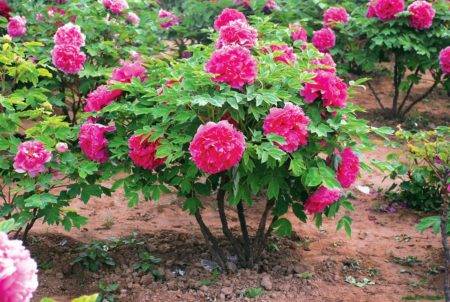

It is often not enough just to cut the bushes and fertilize. For those regions in which winters are long, harsh and cold, and there is very little snow, it is important to cover the plants for the winter so as not to lose them.
First, they spud the bushes. This is done very carefully, because the buds of the new season are located at a depth of no more than 10 cm.Apply mulch on top with a layer of about 18 cm.Use as mulch:
- humus;
- compost;
- dry leaves;
- sawdust.
With the onset of the warm season, the shelter must be removed for air access. Ventilation will help prevent rot.
Snowy winter is another natural stage of plant protection from cold weather. Snow prevents freezing during severe frosts.
Reproduction of peonies by rhizome
Delphinium after flowering (what to do)
The flower can be propagated in several ways: cuttings, dividing the bush, layering and even seeds.
However, the most popular methods are those based on propagation by rhizomes.
1 way
To propagate a peony bush, root cuttings are used.
Cuttings are harvested from the last days of July to mid-October. Plots should be made in such a way that they have one accessory root and at least one peephole.
The order of harvesting cuttings:
- In the spring, it is necessary to dig a peony on one side and cut off the adventitious roots, the diameter of which is at least 1 cm.
- Then this root must be cut into sections 5 cm long.
- Prepared cuttings must be disinfected in a manganese solution for 90-120 minutes. To prepare a disinfectant solution, you need to dissolve 3 g of potassium permanganate in 10 liters of water.
- Next, the plots are dried and the sections are treated with crushed wood or activated carbon. Drying ends when the slices are crusty.
- For better rooting of cuttings, it is desirable to treat them with growth stimulants. For this, the roots are placed for 16 hours in a 0.01% heteroauxin solution.
Planting cuttings:
- Prepare the soil for planting. The soil should be light and neutral (pH 6-7). On acidic soils, peonies do not develop well and can hurt. Peonies grow well on loams.
- Prepared plots are planted to a depth of 5 cm and at a distance of 20 cm from each other.
Thus, several transplants can be performed from one root.
These cuttings should be planted to a depth of 3 to 6 cm and watered well. Renewal buds will be laid for 2-4 years.
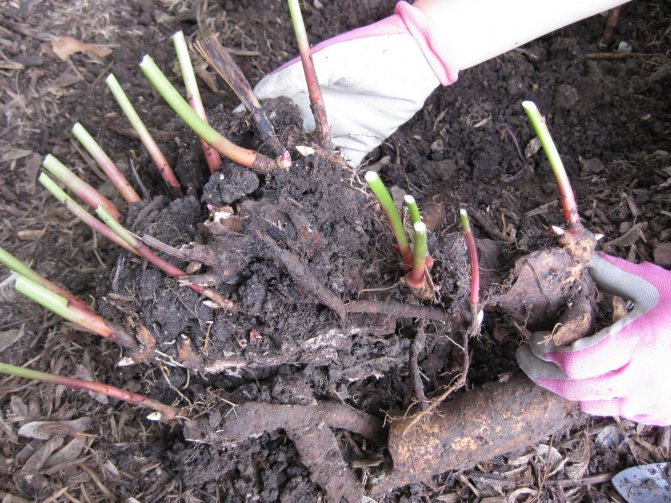

Reproduction of peonies by rhizome
If there are no shoots of young peonies in the spring, then you can wait until next year, since the buds are formed during the summer and will germinate only the next year.
After 2 years, the seedlings are transplanted to a permanent place.
However, this method cannot be applied to all varieties of flowers. For these purposes, a hybrid of Baroness Schroeder, Cowley, etc., as well as a medicinal peony, are suitable.
2 way
It is the main one for the propagation of bushes. This method consists in dividing the rhizome. The division time is April-May or August-September. However, it is preferable to propagate the peony this way in the fall. In the spring, the transplanted plant can immediately begin to actively grow, without even having time to take root. This can lead to bush disease. Also, during this period, the buds quickly start to grow; fragile shoots can be damaged during division.
During the autumn division of the bush, there will be no active growth of the rhizome, therefore, at this time, the transplant is less traumatic.
If the division is carried out in the fall, then the division must be transplanted in such a way that it has time to take root before the onset of frost. Therefore, it is recommended to finish planting before September 15th.
The order of dividing the bush:
- At the mother bush, the upper green part is cut off.
- Gently release the roots from the ground.
- The remnants of the earth are washed off the roots with water. This is to make the kidneys more visible.
- Then the rhizome is dried in the shade for several hours.
- Now the adventitious roots are cut to 10-12 cm in length.
- The roots are cut into plots with pruning shears so that each site has at least one adventitious root and 2-3 well-developed buds. The adventitious roots must be at least 1 cm in diameter.
- When dividing an old bush, you need to check that the roots are not diseased, rotten or damaged.Damaged roots should be pruned and bad areas removed. The cuts are processed with crushed charcoal.
- Now it is necessary to again withstand the plots in the shade so that the places of the cuts dry out.
On a note. If the planting of peonies needs to be delayed, then you can save the plots by placing them in sand or moss.
In this way of reproduction, it is recommended to divide the bushes at least 3-4 years old.
Caring for young peonies consists in timely watering, loosening, mulching and removing weeds. You also need to protect the plants from the sun.
3 way
This option is called pruning breeding. In the spring, after the first shoots appear, they rake the place around the bush. The hole is dug to a depth of about 15 cm. At a depth of 5-7 cm, the roots are cut with a shovel. The resulting rhizome breaks down well into separate parts. Then the hole must be covered with earth, and the site must be mulched. Cuttings are planted in the prepared area as described in method 2.
By the end of the season, the bush will recover due to dormant buds. You can also perform such a division in the fall, only in this case, not only the roots are cut, but also the green part of the bush.
What is the difference between preparing a tree peony for winter
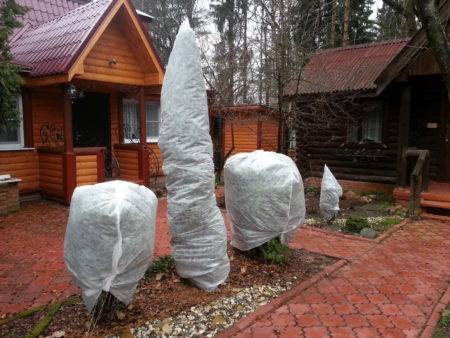

In places where a strong cold wind does not rage in winter, tree peonies do not need additional shelter. But young bushes require protection from the cold, so they apply a twenty-centimeter layer of peat and cover the stems with an inverted bucket, basin, or other container of a suitable height and diameter.
The tree-like peony is recommended to be cut not for the winter, like ordinary varieties, but in the spring.
Watering and loosening
Peonies are watered infrequently, but abundantly. An adult bush requires up to 3 buckets of water 2 times a month, unless, of course, there are heavy rains. When watering, it must be borne in mind that the roots grow farther than the periphery of the bush, therefore water is poured not only "at the root". If it's dry and hot, you may need to water weekly as well.
After watering, shallow loosening of the soil is carried out or mulch it with a thin layer of any loose material. At the bush itself, you should not loosen deeper than 5 cm, further - up to 10-12 cm.
Preparation for wintering shrubs in different climatic zones
Different regions of Russia suggest differences in winter temperature regimes. It all depends on climatic realities, so you need to prepare shrubs for winter in different ways.
- Siberia. Since this is a colder region than all the others, the preparation of plants for frost is more solid. The stems are covered with a thick layer of mulch, and the top is covered with boxes, buckets or any other container that acts as a shelter.
- Ural. In this region, peonies also need additional shelter, and the whole process is exactly the same as in Siberia.
- Volga region. It is enough only to apply a layer of mulch, and it is not necessary to cover it with some other protective containers.
- Middle lane. In case the winter is frosty and snowless, the bushes are covered, but more thorough preparation is not required.
Cut off the stems and feed the roots
Preparing peonies for winter:
- Cut off the stems. In autumn, at the beginning of September, the leaves of peonies die off, which indicates the period of preparation of flowers for winter. It is necessary to cut off all the stems at ground level without leaving any stumps. Remove the leaves and burn. You cannot use them as cover.
- Feed the roots. After pruning, the soil should be well loosened. Feed with humus or bone meal with wood ash in a 2: 3 ratio.
- How to cover. In places with harsh climatic conditions, you can mulch the soil with peat, sawdust or compost.
Video:
Typical mistakes
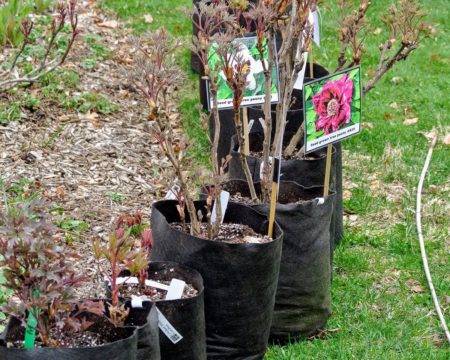

Novice growers often do something wrong in preparing shrubs for the winter months. Some of these errors are the most common:
- Plants are pruned too early, before the first frost occurs, for the sake of the appearance of the flower bed.
- Dried leaves are cut off not in the fall, but at the beginning of the spring season, which creates the prerequisites for the development of diseases and reduces the "immunity" of the plant.
- On rainy days, liquid fertilizers are added, exacerbating the situation. This prevents the complete absorption of top dressing by the roots, the erosion of nutrients along the soil surface, and not their concentration in the tubers.
- Peonies are covered incorrectly before cold weather, they do not take into account the peculiarities of their region, which leads to the death of the bush.
Useful video
How to transplant peonies correctly - video
Peonies have faded - what to do? florist errors - video
Even in the presence of all conditions of maintenance and care, namely watering, fertilizing, loosening, weeding, replanting, without proper pruning, peonies will not delight with their beauty and fragrance. Only timely pruning, and so necessary for flowers, will prepare them for changes in weather, strengthen immunity, give strength and health to lay new buds and ensure lush, abundant and long flowering in the next season. A minimum of care and attention to their pets and they will surely thank the flower growers, become the subject of their pride and admiration.
Planting depth of peonies
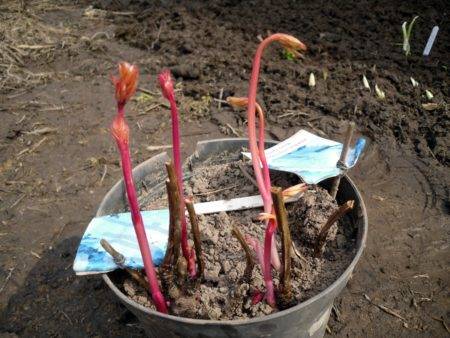

When planting peonies, take into account the depth. The kidneys should be at least 4 centimeters. If you plant them deeper, then the flowering of shrubs will be too poor, although enough shoots are formed, they will not be able to give full flowering. With a shallow planting less than 4 cm, peony bushes die from frost, and new ones will have to be planted next season.
Gardening tips
- After splitting the root part and replanting it is not recommended to water the plants abundantly for the next few months. A young plant absorbs moisture too quickly and, with its excess, the root part will begin to rot.
- After dividing an adult bush into parts, it is not recommended to plant plants in the same area. High-quality development of young crops - a deal is possible only in a new flower garden or flower bed.
- Peonies are very fond of water and in large quantities, but they absolutely cannot stand wet or swampy soil. To prevent water from stagnating, it is necessary to fill the planting hole with reliable drainage material before planting.
- Planting depth is of great importance for the growth and development of a peony. Insufficient depth can lead to the fact that after numerous loosening of the near-trunk space and weeding of weeds, the buds and part of the rhizome will be very close to the soil surface. Additional hilling can save such bushes. Planting too deep will result in no flowering.
- Renewal buds when planting peonies should not be deeper than five to seven centimeters in the ground.
- For planting peonies on your site, it is recommended to use only young plants - seedlings. Massive, overgrown and old cultures in a couple of years will become completely old and stop blooming. All the hassle of planting and leaving will be in vain.
- Without special need, do not disturb peonies with frequent transplants.
- The root damaged during transplantation must be disinfected with a solution of copper sulfate, manganese solution or sprinkled with crushed activated carbon.
- Early pruning of peony foliage (immediately after flowering ends) will cause irreparable harm to crops. The next bloom will be sparse or may not occur at all.
Disease prevention in autumn
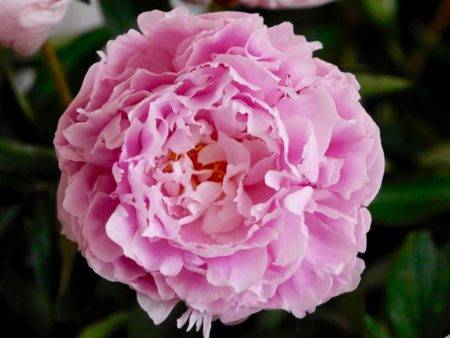

To protect the plant from fungi after autumn leaf fall, the bushes are treated with a three percent solution of copper sulfate or a two percent Bordeaux mixture.
Trying to make peonies more resistant to various diseases and frosts, they use fertilizers with phosphorus or potassium. Moreover, it is more correct to alternate between different compositions for the onset of the best effect.
Why does the peony not bloom
The main indicator of the normal development of the bush is abundant flowering. Sometimes peony bushes refuse to bloom for many years. This can happen for several reasons.
- The bush is planted in a dark place near the building.
- The soil under the bush is very wet and there is no drainage.
- The peony is planted very deeply. The root collar is below ground level at a distance of 5 cm.
- The soil on the site is very acidic. In this case, it must be calcined.
- Freezing of the kidneys during spring frosts.
- Dry soil and lack of nutrition.
- When peonies are cut too early after flowering, and the plant did not have time to take the right amount of nutrients from the soil.
- When planting and dividing the root, the buds are not properly distributed. Weak roots cannot cope with a large number of shoots.
- The plant has not been transplanted for a long time (more than fifteen years)
Pests and how to deal with them
- Bronzes. Fighting these flying beetles is not easy, but it must be done. They eat flowers of light shades, and the plant loses its decorative effect. Pests are collected by hand and destroyed. At night, beetles hide in the ground, so late in the evening, shrubs should be abundantly shed with insecticides for soil pests.
- Halal nematodes. A plant whose roots are damaged by these small worms cannot be saved. Signs are manifested in the fact that peonies become depressed, weak. Plants seem to lack water and nutrition. To make sure that the plant is damaged by nematodes, you should remove the layer of earth, inspect the roots. Signs of damage are brown or yellowish root thickening and fringed roots. The damaged plant is dug up and destroyed so as not to infect neighboring bushes. The soil is disinfected.
- Aphids, ticks, thrips, ants. Peonies are not often affected by these pests. Spraying with insecticides is used to combat. Spraying is carried out in the evening, when the bees stop flying. For prevention, it is recommended to spray the ground under the bushes.
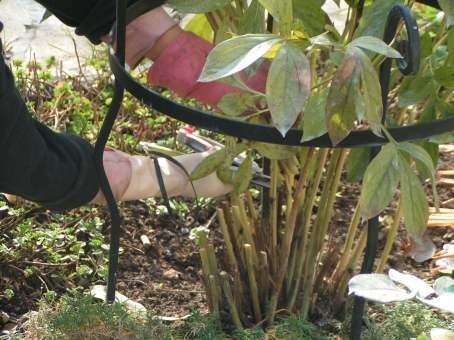

Other procedures: watering, transplanting, prevention and treatment of diseases
Watering peonies after autumn pruning is possible, but not too abundantly, especially for ITO varieties.
If the bushes are overgrown, they should be planted. This procedure should be carried out in the velvet season (late August-first half of September), when the weather is warm, dry. The peony will get used to a new place, take root and grow quickly in the spring.
In spring and summer, it is better not to plant or transplant a peony - all the plant's forces are directed to flowering and seed production, so the risk of death is very high.
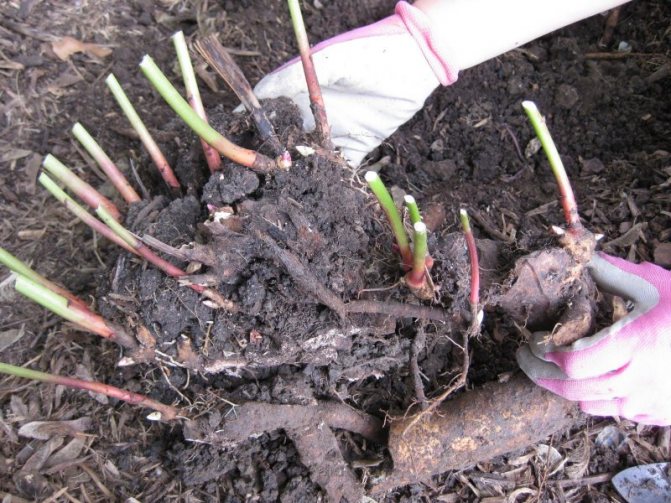

Whichever method of feeding you choose, you need to apply fertilizers very carefully so that additives do not fall on the root neck of the peonies
How to plant peonies in the fall:
- Choose a fertile, loose soil, preferably black fallow (an area that has been “resting” for a year) or land that has previously grown legumes. The landing site should be sunny, not windy, away from buildings and trees.
- 4 weeks before planting, dig ditches with a diameter and depth of up to 0.5 m, at a distance of 1–1.5 m from each other. Place drainage on the bottom: sand, gravel and water to settle the soil.
- Mix black soil with humus, sand, manure, peat and ash in a 1: 1 ratio. Pour the mixture into the hole, mix with the garden soil. You can also add urea, superphosphate, ferrous sulfate.
- Cut the peony stems to 15 cm. Carefully dig up the old bush. Shake off the soil and leave the dug out bush in the shade for 2 hours so that the roots are not brittle.
- Inspect them, remove damaged and dried ones. Cut large ones at an angle of 45–60º, leaving a length of 10–20 cm. Sprinkle the slices with crushed charcoal. Place the roots in a light pink potassium permanganate solution for half an hour.
- After soaking, plant the young peonies in separate pits, placing the buds 4–5 cm below the surface. Each division should have 2-3 shoots, 3-4 roots and growth buds.
The most gentle method of dividing a dug out bush is to plant it on a 40-50 cm stake. The bush will spontaneously disintegrate into the required divisions.
Video: peony transplant
Peonies can be affected by fungi (spots, powdery mildew, gray mold) or pests (bronzes, aphids, caterpillars and root nematodes). Trim off infected stems, leaves or roots and burn off site.
Caring for peonies will not take much of your time - these flowers are perfectly adapted to survive in the cold. The main thing is that in no case should you neglect autumn care, because during this period the health of the plant is laid. Dedicate a day or two to your favorite flowers, and they will thank you with lush flowering and delicate aroma.
Pion disease control measures
- Rust attacks the leaves. Dark spots appear on top, the lower part of the leaf is covered with red spores. The diseased foliage is cut and burned. Any preparations containing copper are used to combat.
- With brown spot, the plant can get sick with high humidity. Brown spots appear on the leaves, which quickly cover all foliage and buds. Copper preparations are also used for treatment.
- With a circular mosaic, circles of a light green or yellow color are formed on the leaves. It does not harm the life of the plant. To fight the disease, it is enough to cut and burn the affected foliage.
- The plant can get sick with gray rot in cold and humid weather. Peonies planted on heavy clay soils are also susceptible to this disease. The damaged parts of the bush are cut off. Bordeaux mixture is suitable for treatment.
Do I need to cover for the winter?
Peony has a high winter hardiness and, according to the generally accepted opinion, herbaceous species and varieties can withstand up to -40 Cº (zone 3 according to USDA). Therefore, adult bushes do not need winter shelter in the Moscow region, the Leningrad region, and even in the Urals and Siberia.
They also do not need to be dug up. Before wintering, it is enough to inspect the base of the bush so that the rhizome does not peep out of the ground and, if necessary, sprinkle it with soil a little.
Young peony
Young bushes (1-2 years old), cuttings, cuttings, shop seedlings OKS and ZKS in the first year of planting must be prepared for winter.
Before the onset of constant cold weather (October-November), sprinkle with earth or sprinkle with a 5-7 cm layer of peat (except for acidic soil) or old aged compost (3-4 years). After the snow melts (March-April), the mulch will need to be raked out.
Pruning
Faded bushes cannot be cut off immediately, the process of photosynthesis is disrupted. But it is not worth leaving this event for the spring, fungi, bacteria and pests happily multiply in the withered stems.
For the same reason, I do not recommend covering the bushes with cut mass for wintering. Anything that gets under the pruner is immediately burned. Before processing each bush, the instrument is disinfected again.
The optimal pruning time is considered to be the time when 1-2 weeks are left before frost. It can be difficult to calculate this, but with close observation, the peonies themselves will give a hint. As soon as the leaves have changed shade and began to slope to the ground, you need to remove them. The green mass is cut flush with the ground, you do not need to leave hemp and go deep into the soil, this will harm the plant.
Useful Tips
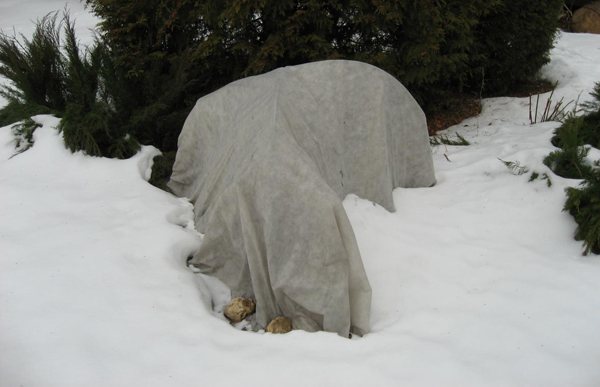

In order for peonies to be always beautiful and healthy, you need to heed the advice of knowledgeable florists.
- If the peony bushes have grown, they need to be planted. The thickening of flowers leads to their defeat by diseases and pests, and complicates the shelter of bushes (tree-like). This procedure is carried out at the end of August - the first half of September, when the weather is dry and warm. Peonies adapt to a new place, take root and grow quickly with the arrival of spring.
- You can fertilize peonies only 3 years after planting.
- Before pruning, peonies are covered with non-woven material at night.
- If there is a need for earlier pruning of leaves, then 2-3 leaves are left on each stem.
- The concentration of fungicide solution when treating young plants from diseases is reduced by 2 times. Adult peonies are sprayed according to the dosage.
- To protect flowers from frost, the height of the shelter of peonies should be 10-20 centimeters.
- Cut peony foliage is not used as a covering material. It attracts pests and diseases.
- During the winter, peonies can be additionally covered with a layer of snow. This serves as additional frost protection.
- Bushes growing along fences, buildings or under trees are the least covered. The snow cover on them lingers in a natural way.
- In the spring, after the soil thaws, as soon as buds appear on the peonies, the shelter is removed, the mulch is removed and replaced with a new one.
Diseases and pests
Peony bushes under the influence of various factors can be affected by diseases and pests. Diseases of peonies:
- Gray rot. A type of fungal disease that affects stems, leaves and buds. The cause of gray rot is excessive humidity. On the leaves and stem, you may notice the appearance of unhealthy spots with a gray tint. The infected parts of the plant are cut and burned. Copper sulfate (4 g per 1 sq. M), iodine solution (1.5 ml per 600 ml of water), infusion of onion husks (20 g per 1 l of water) are used as prevention and control;
- Brown spots. With a lack of phosphorus, brown spots begin to form on the leaves. Since a bush can grow in one place for more than 20 years, the earth is often depleted, and even with regular feeding, an insufficient amount of minerals is supplied to the roots. To avoid brown spots when preparing a hole, bone meal is added to it. This will provide the bushes with organic phosphorus for a long time.
Lush bushes with fragrant peonies will adorn any garden. A perennial plant does not require special attention in terms of cultivation. A novice gardener can independently propagate peonies in a garden plot from one bush. If you take note of the tips and tricks for planting, how to care for peonies so that they bloom well, the better to feed the peonies, then the bushes will grow healthy and beautiful.
Top dressing of an adult and a young peony: what is the difference
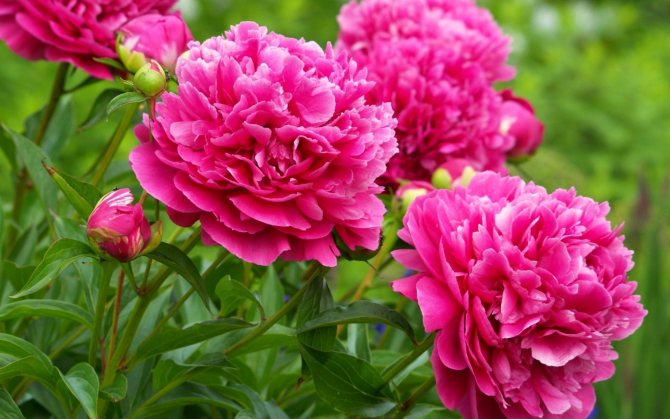

The older the peony, the smaller the buds
The age of the plant significantly affects the principles of autumn feeding. So, a peony younger than three years old should not be fertilized - it receives the necessary nutrients from the soil. A young plant can die if fed without good reason. With adult peonies, the opposite is true: the older the flower, the more nutrition it needs.
Autumn is time to replant peonies
Peonies grow in one place for a long time - up to 15 years. The need for a transplant arises in cases when:
- The previous place for the plant was not chosen well: there are groundwater nearby, nearby plants have grown quickly and give a lot of shade, there have been changes in the design of the garden;
- It took a peony to multiply. Growing from seeds is a laborious process, and by dividing an adult bush into several parts, gardeners get a sufficient amount of planting material.
- There were few flowers on the bush, and they were crushed. If the peony grows in the garden for a long time, then the cessation of abundant flowering is an indicator that the bush is old.
The best time for dividing the bushes and replanting is September. Plants planted in the fall are 99% rooted. At this time, it becomes cool and rainy, which is optimal for the survival of seedlings. The growth period ends, the foliage dries up, and the young roots are still growing. There is enough time for rooting before frost.
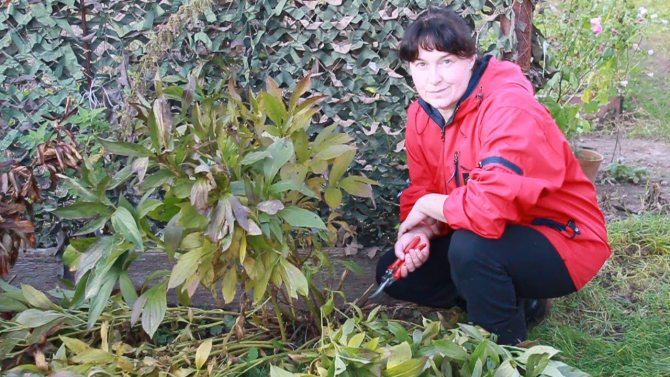

Features of preparation of different types


Peonies for the winter must be covered
The list of preparatory measures depends on the type of plant and its variety, since the level of frost resistance is different for them, as are the requirements for care.
Tree-like
More than 500 varieties are known. The most popular are: Sapphire, Coral Altar, Green Jade, Delaway, Lemoine.
They are tall (up to 200 cm), the structure of the shrub is powerful, the branches are fragile.They do not bend, but immediately break, so the first concern is to keep them intact.
First of all, all the leaves are removed when the air temperature drops to 3-5 °. The branches are divided into how many bundles and fixed. The root zone is mulched with peat, the branches are covered with non-woven material, spruce branches.
Young bushes are covered with an inverted box or bucket to prevent the branches from breaking under the weight of the snow that has fallen. Regardless of the variety, color and size of the buds, autumn care will be the same.
Herbaceous
They have a large number of varieties. The flowers can be very simple or densely double.
Most often purchased for planting: Avangard, Iceberg, Aza Gray, Aquarelle, Bakai Bell, Victoria, Varenka, Diana, Mercedes.
The culture is cut almost at the root, it is very easy to cover the remaining parts of the plant. It is enough to stretch the covering material over the stumps, insulate it with peat or humus. After the snow falls, a snowdrift is thrown over the place of growth of the bush.
Ito hybrids
They are the most stable, bred to grow in cold regions, so they do not require additional protection in warm winters.
The varieties are not afraid of frost: Bartsella, Border Charm, Viking Full Moon, Garden Treasure, Dark Eyes, Julia Rose, Kellis Memori.
When the winter is too harsh, the shelter is carried out according to the general principle.
Planting peonies in the open field means that they need to be carefully covered in the fall so that they can safely survive the winter.
Choosing a place and preparing the landing pits
Peonies love a sunny, windless place. Bushes growing in the shade almost do not bloom, and their few flowers become small. Planting close to a house or other buildings is also not recommended - strong overheating in sunny weather from the walls of the building is possible.
The best soil is neutral or slightly acidic. If the soil is acidic, then lime, chalk or dolomite flour should be added to it.
Peonies do not tolerate stagnant water or an arid place:
- In the case when the groundwater at the site comes close to the surface, it is necessary to pour a drainage layer on the bottom of the pit - stones, expanded clay, pieces of bricks. You can plant a bush on a raised bed. But if the winter is frosty and with little snow, you should not do this - the flower buds will freeze and there will be no flowering.
- Sand should be added to heavy clay soils and a lot of humus.
- For sandy loam soils clay is required.
It is advisable to plan places and prepare pits in advance, 3 to 4 weeks before disembarkation. This must be done in order for the prepared land to settle before the landing of the cuttings.
The hole should be 50-60 cm in diameter and the same depth. At the bottom of the pit, drainage is poured, if necessary. Further, a fertile layer of about 20 cm is laid - compost, leaf humus. Everything is spilled with water.
A nutritious land mixture is prepared separately for planting. It should consist of the following components:
- compost;
- rotted manure;
- wood ash;
- potassium sulfate 200 gr.;
- bone meal 400 gr.;
- superphosphate 300 - 400 gr. If dolomite flour was introduced into the ground to reduce acidity, then superphosphate cannot be added. They are not compatible with each other.
When the planting soil is prepared correctly, peonies can not be fertilized for 3-4 years.
Top dressing
Abundant flowering depletes the plant. In the spring and summer, energy was spent on the growth of green mass and the formation of buds. The root system was left with miserable crumbs, and it is undesirable to send the plant for wintering in this state. With severe depletion (especially on poor soils), it may simply not survive long frosts.
Peonies are unpretentious in care and do not require complex multi-stage feeding, but there are still features in care.
First of all, at the end of the season, preference is given to potassium and phosphorus fertilizers. It is these substances that strengthen and nourish the roots, enhance immunity and increase the plant's frost resistance.
I use potassium sulfate (at the rate of 40 g of granules per 1 bush) and superphosphate, which will take 50 g per 1 m2 (or approximately 1 adult bush).
It is most correct to start feeding peonies from the end of July, alternating mineral and organic fertilizers.
Mineral fertilizers are applied in dry and liquid form. In the first case, the action is longer and dosed. The granules are simply scattered over the root zone in compliance with the amount recommended in the instructions. In the process of watering, they gradually dissolve and are absorbed by the root system.
Important! In peonies, the bulk of the roots are located along the perimeter of the crown, there are almost none of them directly under the stems. This must be taken into account when distributing the top dressing.
The advantage of the liquid version is additional soil moisture during dry periods. In this case, you need to make sure that the tablet or granules are completely dissolved, and the solution does not get on the stems and the root neck of the plant.
As organic dressings for peonies are used:
- compost that saturates the soil with a whole range of nutrients, making it lighter and more permeable to water;
- wood ash, which contains large amounts of calcium, phosphorus and potassium;
- crushed green manure, at the same time serving as additional protection of roots in severe frosts (mulch).


Dry granules of mineral fertilizers are simply scattered over the root zone.
Autumn flower pruning technology
To confidently start pruning, consider all the nuances of autumn peony care.
When the time for the procedure has already been determined, it is necessary to pay attention to the rules that should be strictly adhered to.
You need to remove the aerial part of the plant, carefully cutting off the leaves and stems with a sharp tool.
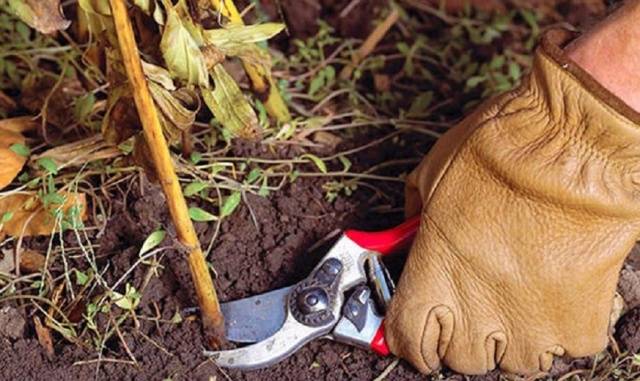

It is even slightly buried in the ground to remove the necessary parts. The exception is the stems above the growth buds, they can be left. The length of such stalks should not exceed 4-5 cm. Although you can determine for them another, convenient length for you.
After the pruning procedure, you need to collect plant residues, take it outside the garden and burn it.
Peat and humus are excellent materials for sheltering flowers in the fall. They will not only protect the peonies from freezing, but also additionally warm the plants.
Experienced flower growers sprinkle the soil and cut areas with wood ash. It simultaneously disinfects and nourishes the future luxurious flowers at the moment when the autumn pruning is already completed.
Mistakes that gardeners make
In caring for peonies, some gardeners make a number of mistakes.
- Pruning immediately after flowering. It is necessary to wait for autumn - by this period the plant will gain strength and get stronger.
- They miss the favorable time for an autumn haircut. Untimely cut bushes can rot.
- Not everyone correctly covers flowers for the winter, especially for residents of the middle climatic zone. Spruce spruce branches, dry leaves, agrofibre, plastic wrap are used as insulation.
Top dressing in autumn
Often, gardeners, having learned that flowers can be fed in the fall to increase winter hardiness, ask me how to deal with peonies in this matter.
I must admit that from year to year this issue does not lose its popularity, and there has not yet been a single September that I was not asked about it.
I always answer something like the following: “A healthy and strong plant really tolerates winter better, but peonies do not need to be fertilized in autumn. Carry out the last dressing immediately after flowering (2-3 days). If an adult large bush bloomed profusely, and you cut off half of the flowers, then you can still feed it 15-20 days after flowering. "
For feeding, use only potassium-phosphorus fertilizers (1 tablespoon potassium and 1.5-2 tablespoons superphosphate per 10 liters of water). It is strictly forbidden to use nitrogen, otherwise the bush will not have time to prepare for winter and will become more vulnerable to pests and diseases.
- In the magazine "Holiday of Flowers" in the general article on the care of peonies there is all the information. Use it to your health!
Quick tips and advice
- You can not plant peony bushes close to each other. The optimum distance is 1 meter.
- In a dry summer, it is necessary regular and abundant watering.
- To prevent diseases, weeding and loosening of the soil are carried out. Preventive spraying will prevent diseases from developing.
- Plantings should be inspected regularly for the presence of pests.
- Choosing the right place and timely feeding will allow the plants develop correctly and bloom profusely.
- In the presence of large, heavy flowers, it is recommended put a support and tie up the stems.
Top dressing of peonies in spring and summer
If fertilization was not applied when planting peonies, then it is necessary to feed the flowers from the first year:
- The first feeding is carried out when the shoots start to grow.
- The second is at the moment of bud formation. Nitrophoska is added to the first and second dressing.
- Fertilize for the third time after flowering. The best food for peonies during this period is superphosphate and potassium sulfate.
For adult plants, a different composition of dressings is required:
- Nitrogen and potassium fertilizers are taken 15 grams each and scattered around the bushes in the snow. This is done during the onset of thaws. When the snow melts, the fertilizer will go into the soil to the desired depth.
- When buds are formed, phosphorus fertilizers are added to nitrogen and potassium fertilizers. They contribute to the better formation of full-bodied buds. Prepare a mixture: 10 gr. nitrogen, 15 gr. potash and 20 gr. phosphorus fertilizers.
- In the third feeding, after flowering, fertilize only with phosphorus (20 gr.) And potash (15 gr.) Fertilizers.
Peonies love foliar feeding with mineral fertilizers. It is better to spray on a cloudy day. In the heat, there is a possibility of leaf burns. On a sunny day, it should be sprayed early in the morning or in the evening.
Peony bushes respond well to fertilization with organic fertilizers - manure. Such feeding is carried out at the beginning of summer. Manure contains nitrogen, which is required by the plant only in the initial growing season: 0.5 buckets of manure are added to 30 liters of water and left to ferment for 10 days in a sunny place. For this process, it is better to choose a distant section of the garden, because an unpleasant odor is emitted during fermentation. Then wood ash and superphosphate are added. The finished composition is diluted with water in a 1: 2 ratio. A bucket of such fertilizer is poured under each bush.
A good top dressing can be made from rye bread: Break the loaf into pieces and pour a little water over it. Fermentation lasts 10 - 12 hours. Fermented bread is bred in 2 buckets of water. Such fertilization can be carried out all summer long at intervals of 2 - 3 weeks.
When fertilizing peonies, it is important to remember that it is better not to feed than to overfeed. An excess of fertilizer leads to the fact that the bushes grow a lot of foliage to the detriment of flowers.
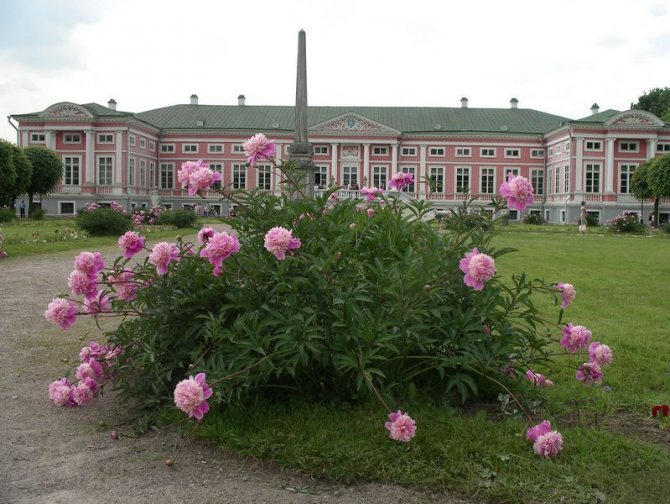

Herbaceous and tree peonies
Peonies planting and care in the open field
The easiest way to breed peonies is to divide the bush. It is allowed to divide the bushes at the age of at least 3 years. When dividing, young bushes may begin to fade, so it is undesirable to disturb them for the first two years.
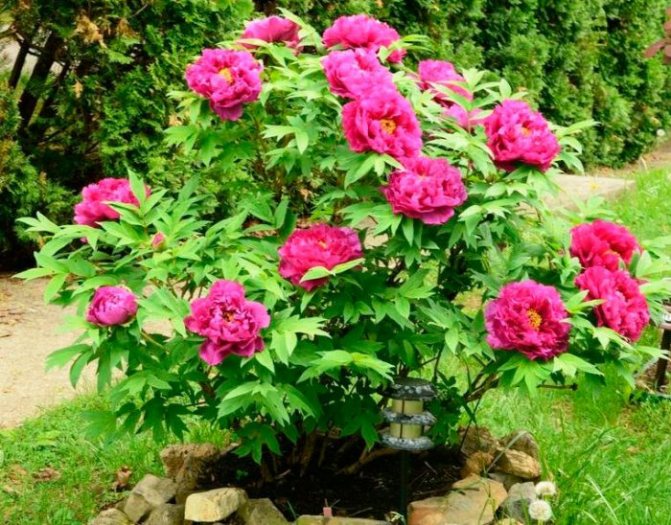

Tree peonies
The optimal time for breeding is the beginning of autumn. In September, the sun is no longer active, the days are not hot. Plus, during this period, the rainy season begins, so the earth will be sufficiently moistened, and the roots will quickly take root in a new place.
Instructions for reproduction by dividing the bush:
- Dig out the rhizome and carefully cut it into pieces with a sharp knife;
- Each cut piece should have 3-4 healthy buds and good roots;
- If there are damaged roots, then they must be removed;
- The planting material must be disinfected in a weak solution of potassium permanganate. The roots are placed in the solution for 2 hours. This is a preventive measure against root rot;
- Places of cuts must be sprinkled with coal or wood ash;
- After carrying out all the procedures, the roots are placed in a dark place so that they dry out a little;
- After that, you can plant peonies in a prepared place.
Sometimes seed propagation is used. But this method is used mainly by breeders to develop new varieties. This process is laborious and time consuming. The first flowering occurs only 5 years after planting.
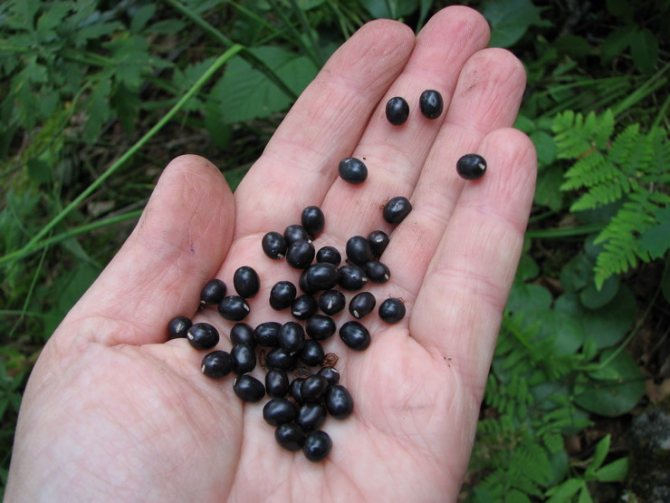

Peony seeds
Description of technology
There are two varieties - herbaceous and arboreal. They differ in shape, size, color, flowering time and tuber height.
When the peony has faded, buds develop, which will begin to bloom the next year (they form at the base of the plant).
When pruning, it is important not to remove all the foliage, but to leave 2-3 pieces.
Herbaceous species are cut at the root. But with tree-like ones, you need to be extremely careful: the ground part is not touched, the cut should be 2-3 cm higher than the kidney, and the height of the stems is at least 20 cm.
Features of pruning a tree variety
The older the tree peony, the more lush the bush. By the end of each season, the shoots do not die off; on the contrary, they grow, thereby giving the plant a spherical shape.
It should be cut strictly in autumn or early spring, before flowering. Only damaged, dry and weak stems need to be removed.
Young peonies are not completely cut off, experienced gardeners remove only a third of the bush.
If you want fewer flowers, then the buds located on top do not need to be touched.
It is necessary to cut the leaves only in the fall and only if the plant is sick.
To prevent the development of diseases, the culture is treated with copper oxychloride. The finished powder can be purchased at agricultural stores. The solution is made at the rate of 1 pack (40 g) per 10 liters of water.
Leaving after flowering in summer
Peonies differ in the color of the buds, the beginning and the duration of flowering. Some varieties start blooming in early May.
Peony care after flowering
At the end of June, by the beginning of July, the flowers wilted. If you cut off the side buds during flowering, then the central one will turn out to be large. By pruning a withering main flower, the lateral blooms can be extended to bloom.
As soon as the plant has completely faded, the wilted buds are cut off.
How to cut peonies for a bouquet
Garden lily, chrysanthemums, peonies grow in every country house. One cannot help but love bright and fragrant flowers, from which you can assemble a bouquet and put in a vase.
In order for the bush to continue to develop normally after pruning the buds, you need to know a few rules on how to cut flowers:
- At least 2-3 leaves should remain on the stem from which the peony is cut;
- The lateral buds are cut first, so the bush will grow more magnificently;
- You can cut flowers in the third year of the bush's life.
If you follow some simple tips, you can collect a large bouquet of beautiful peonies every year, without harming the main bush.
On a note. The question often arises, if the peonies have completely faded, then is it possible to cut the tops. It is recommended to harvest the stems and leaves in late summer - early September.
Pruning peonies
After all the buds have wilted, the bush needs preventive pruning. Peonies begin to bloom by the end of June.
A month after flowering, buds begin to form and develop. With proper care, the bush will be healthy and beautiful.
Withered heads must be trimmed to the first leaf. This procedure allows you to increase the frost resistance of the plant, prevents the appearance of gray rot.
If the variety grows very large flowers, and they bend over the stems of the bush, then it is necessary to establish a support around the plant. If there are a lot of flowers, then you can cut off some. It is better if the buds are cut with a garden tool.
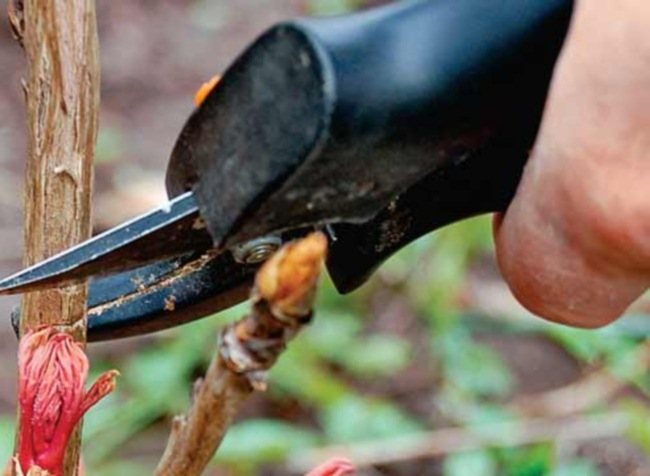

Pruning peonies
Top dressing
If the soil is fertilized in a timely manner and dosed, then the peony bushes will be lush and healthy.Feeding peonies allows you to accelerate the growth of the root system, is responsible for the formation of buds, and increases the plant's immunity to various diseases. Feeding peonies in spring and summer is responsible for flowering activity.
Organic fertilizers alternate with mineral fertilizers. It is important to consider the recommended dosage so as not to burn the bush.
Note! With proper fertilization during planting, the bushes do not need to be additionally fed for the first year.
Mineral and organic fertilizers are used as additives for feeding peonies:
- Ammonium nitrate (15 g per bush);
- Superphosphate (10 g per bush);
- Potassium preparations (5 g per bush);
- Rotten manure;
- Compost.



